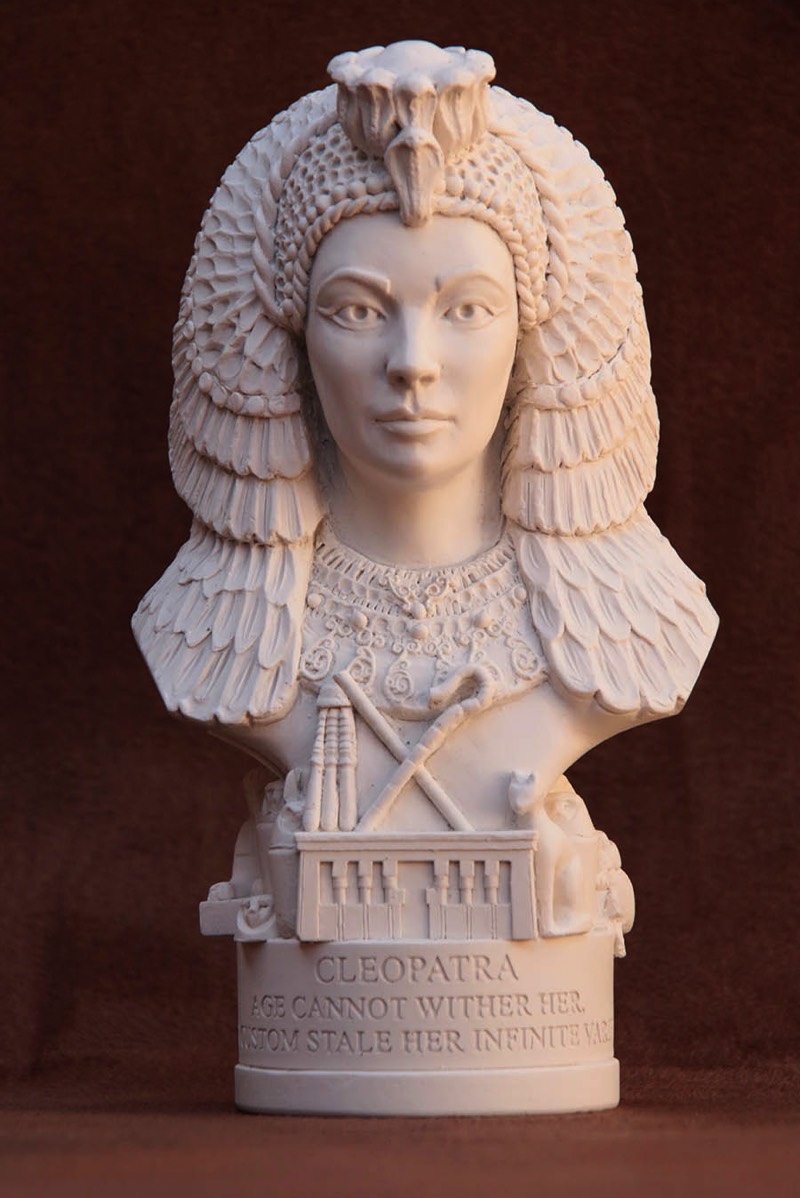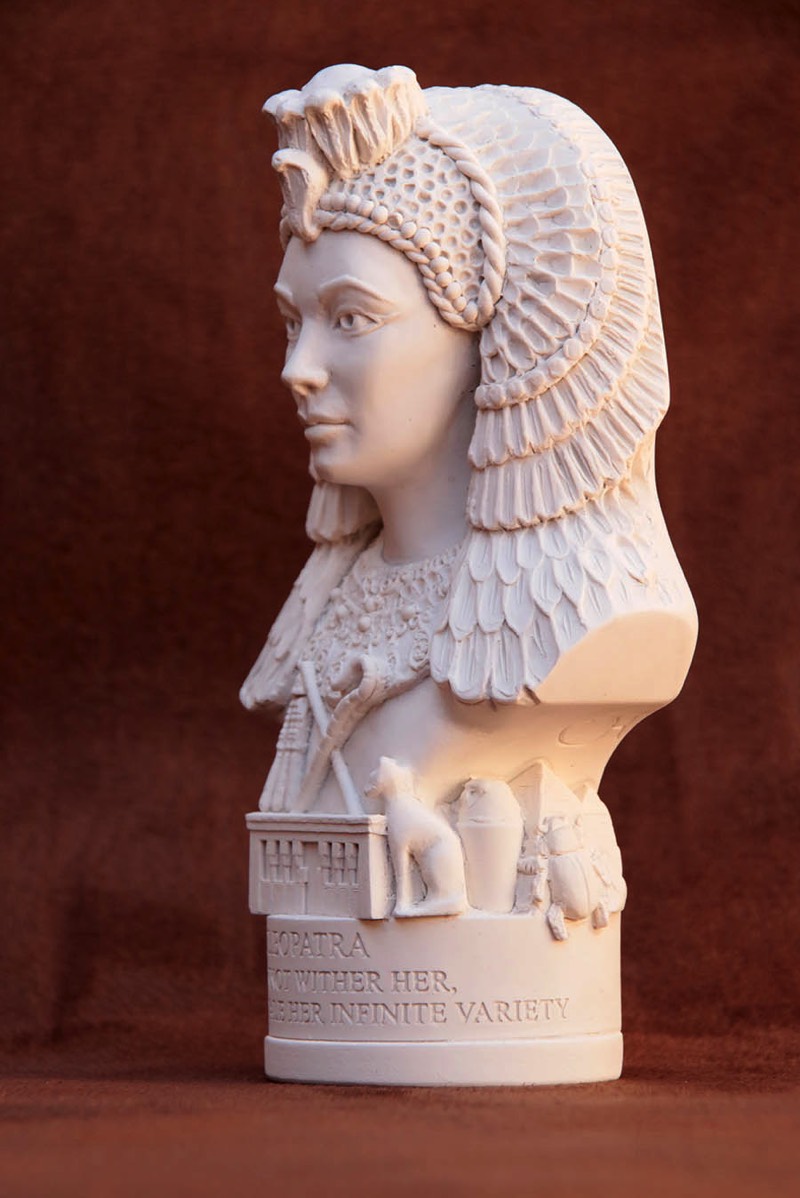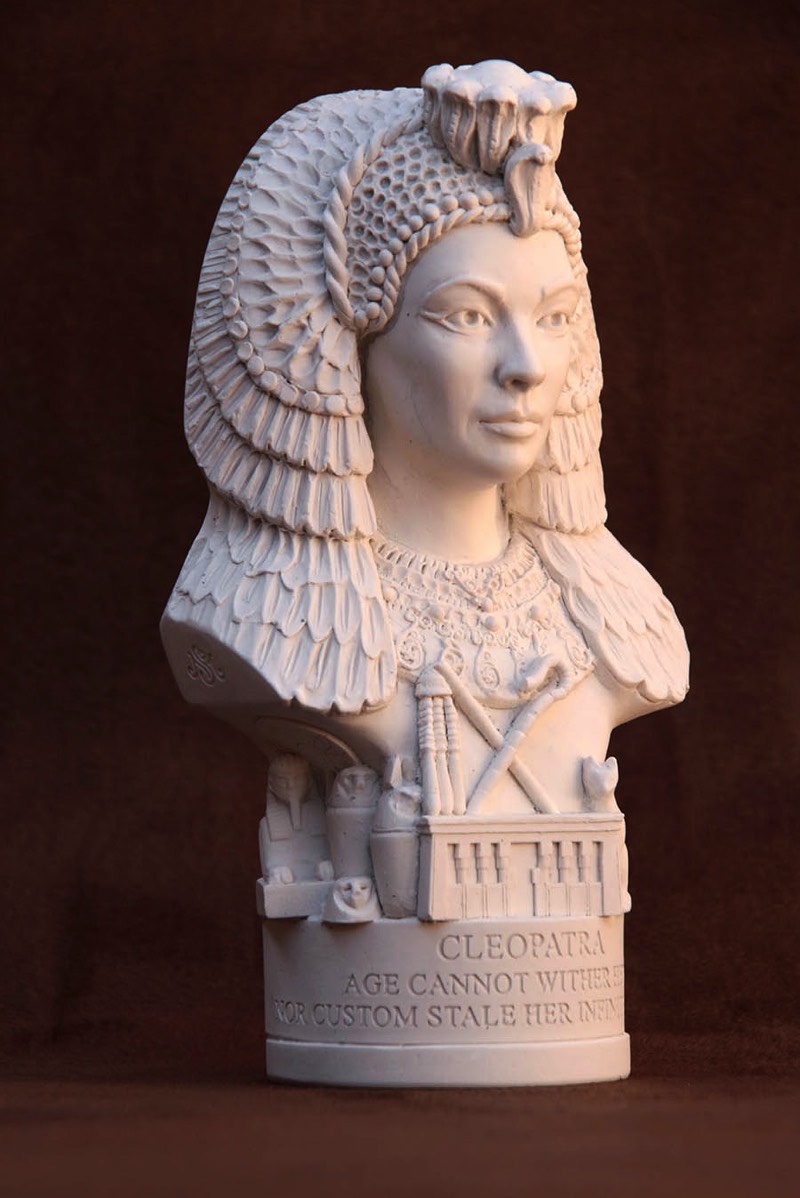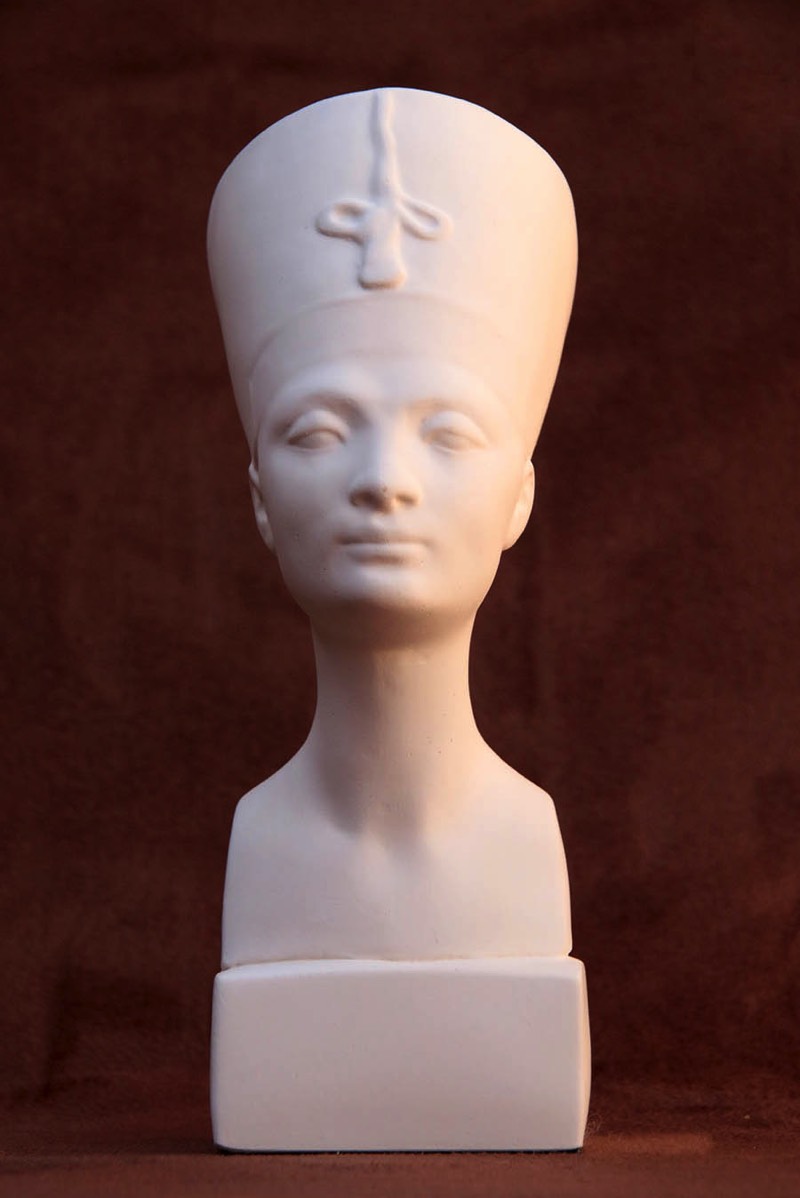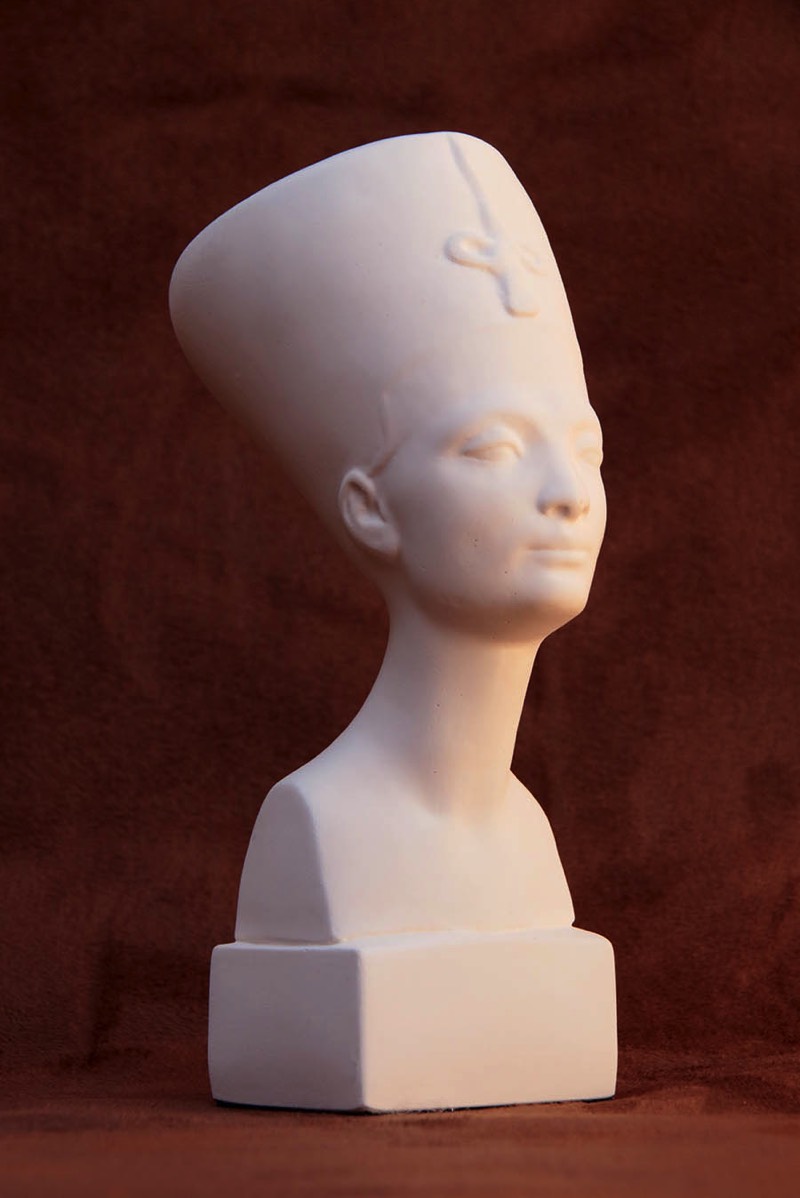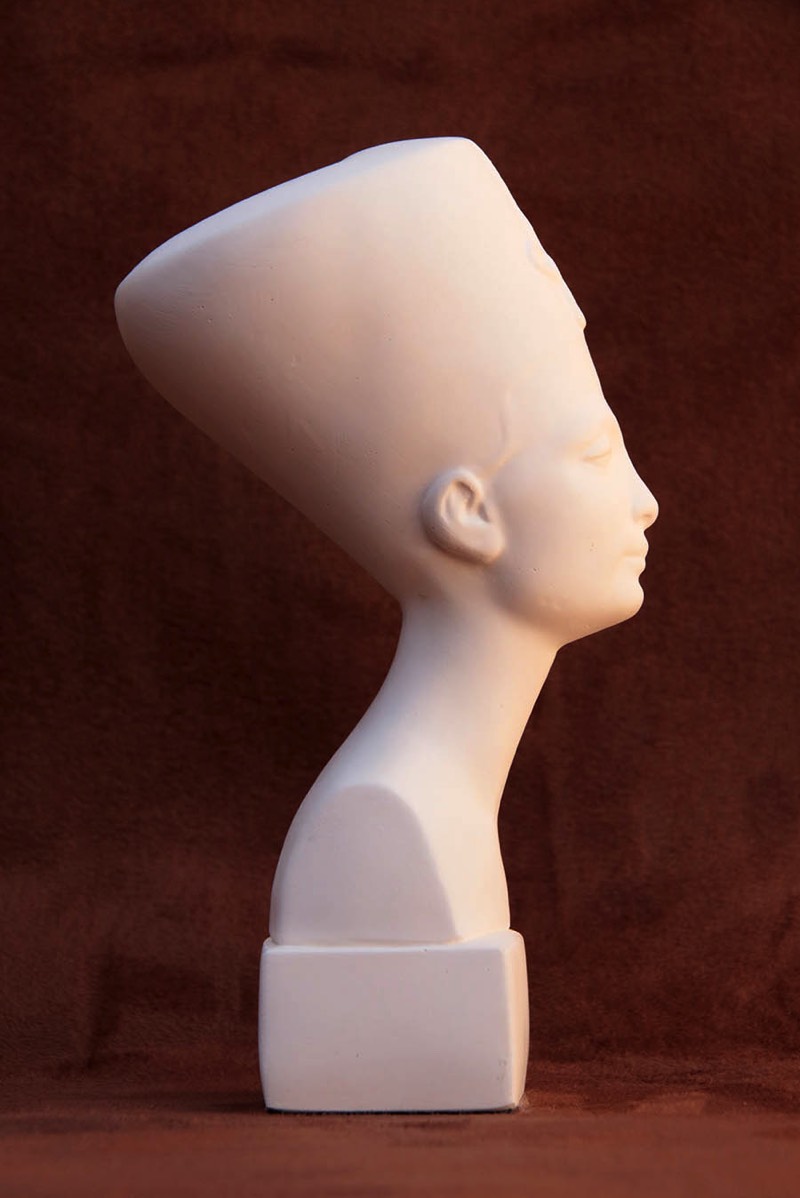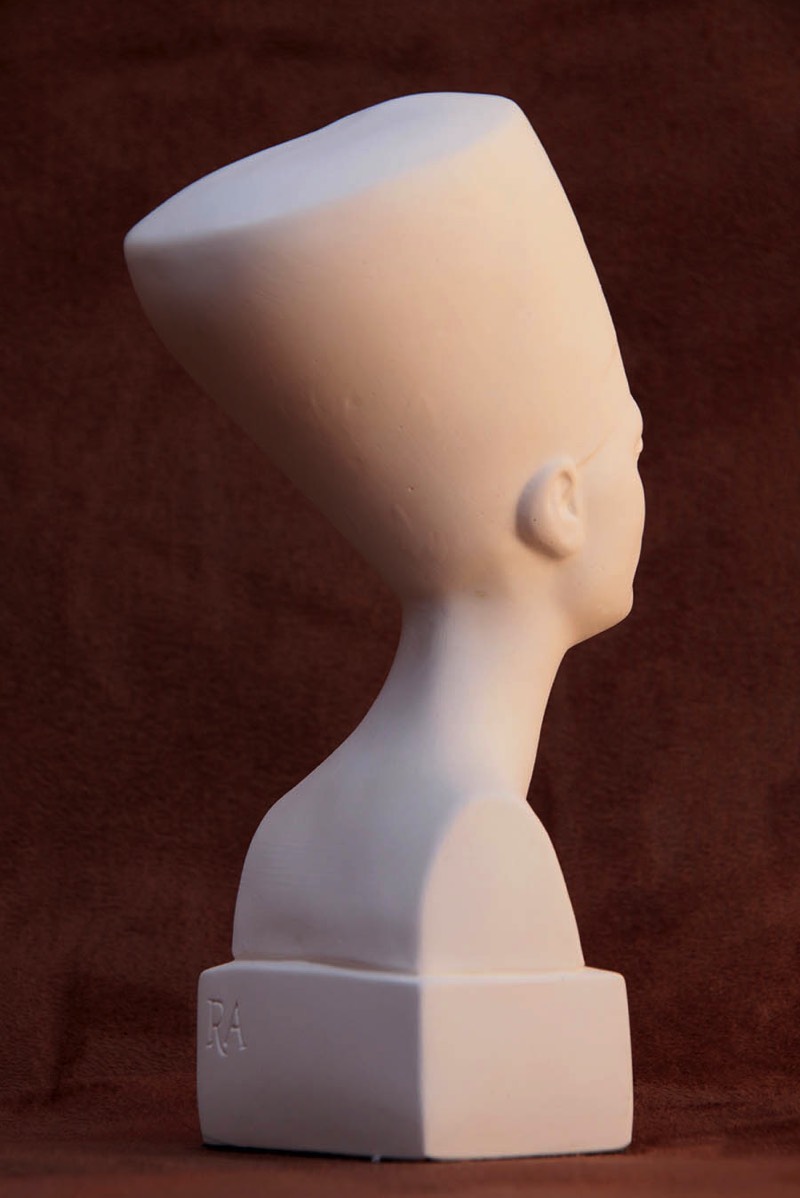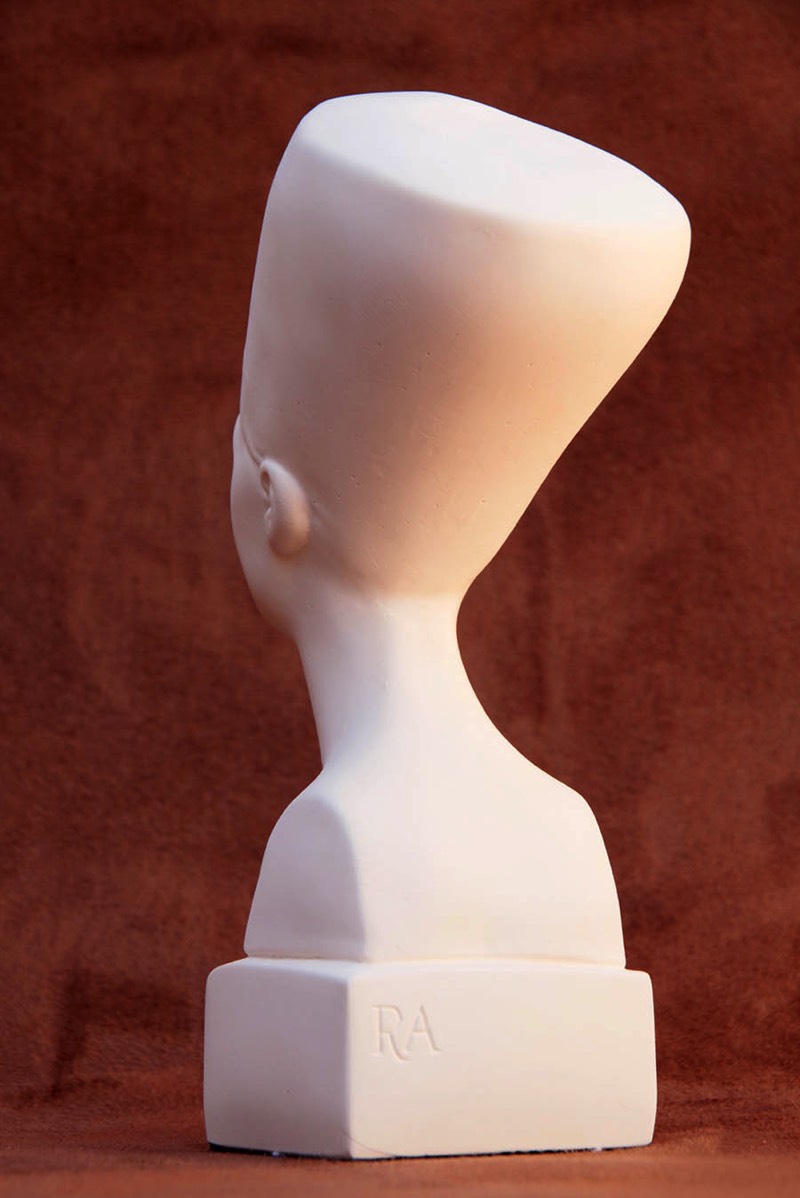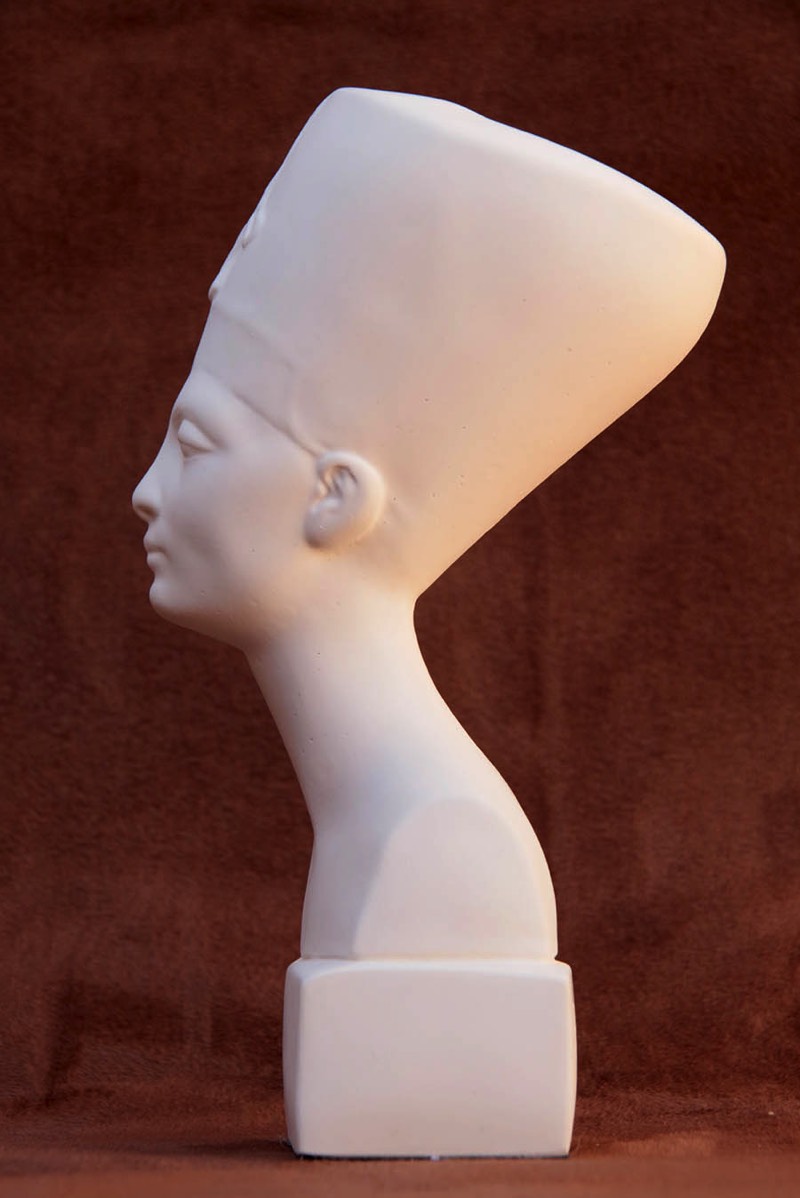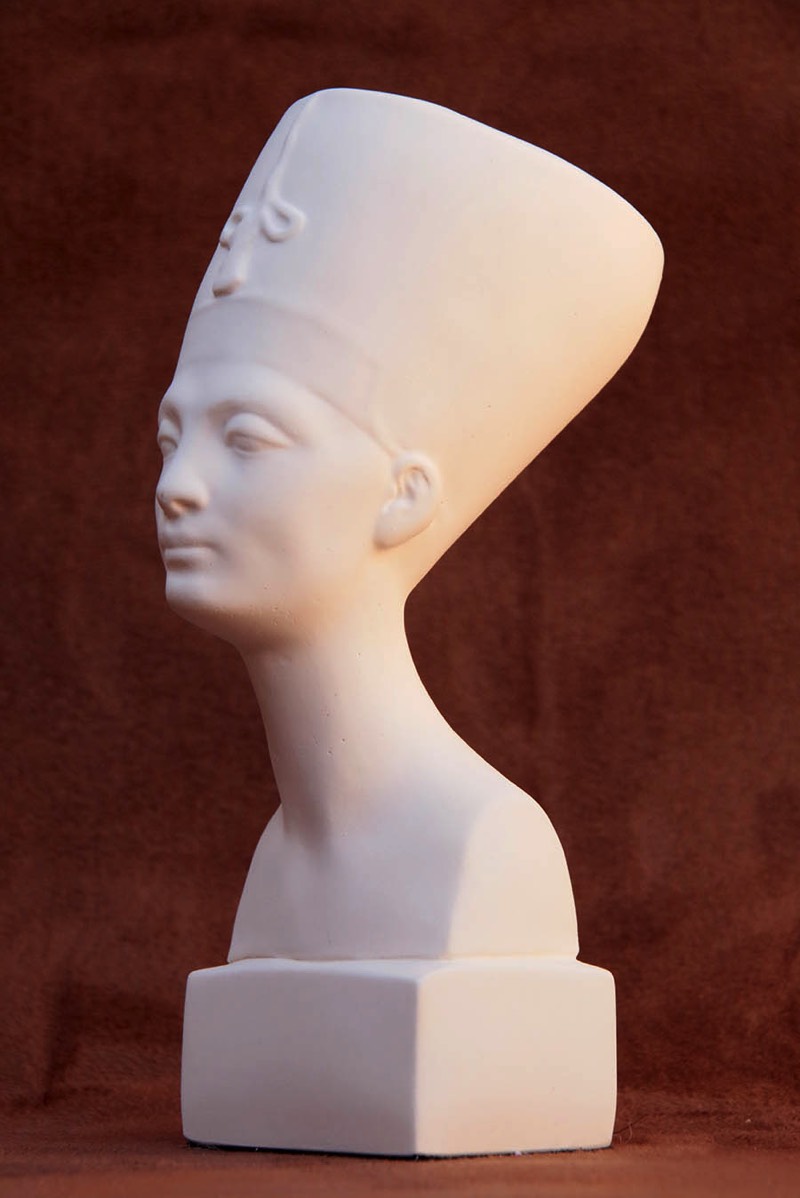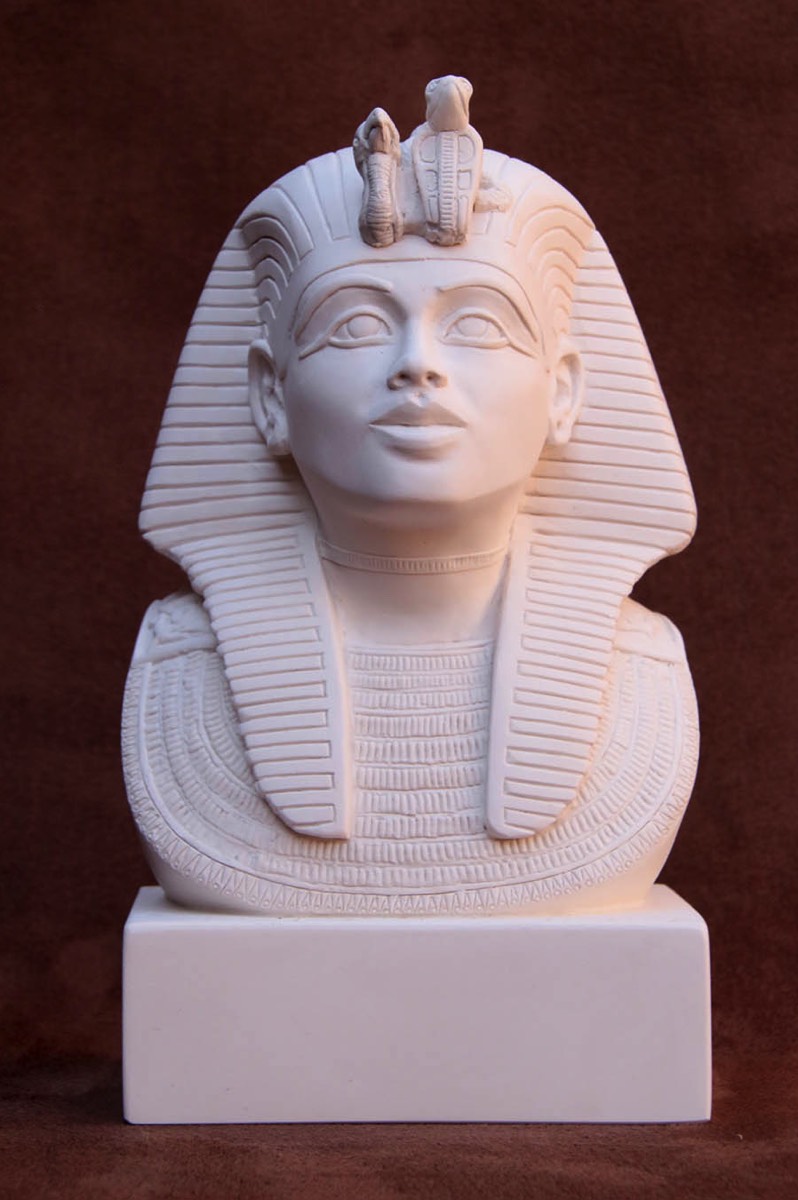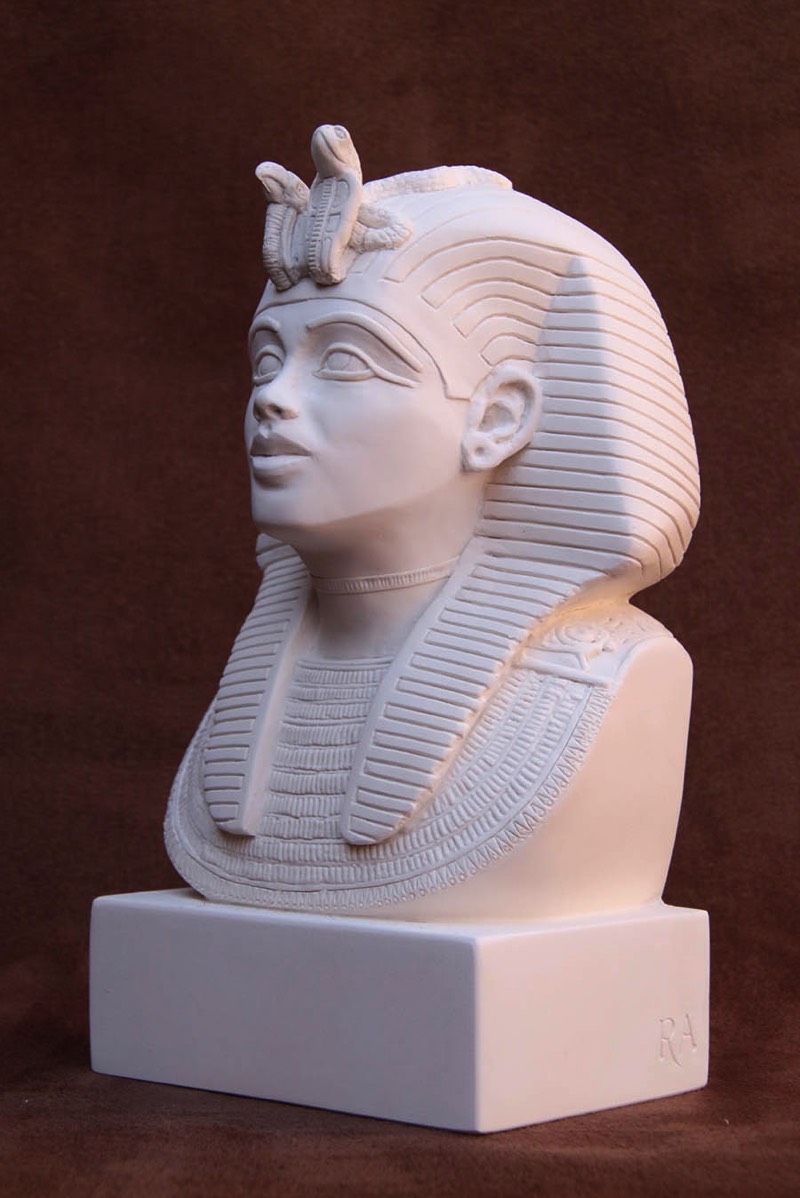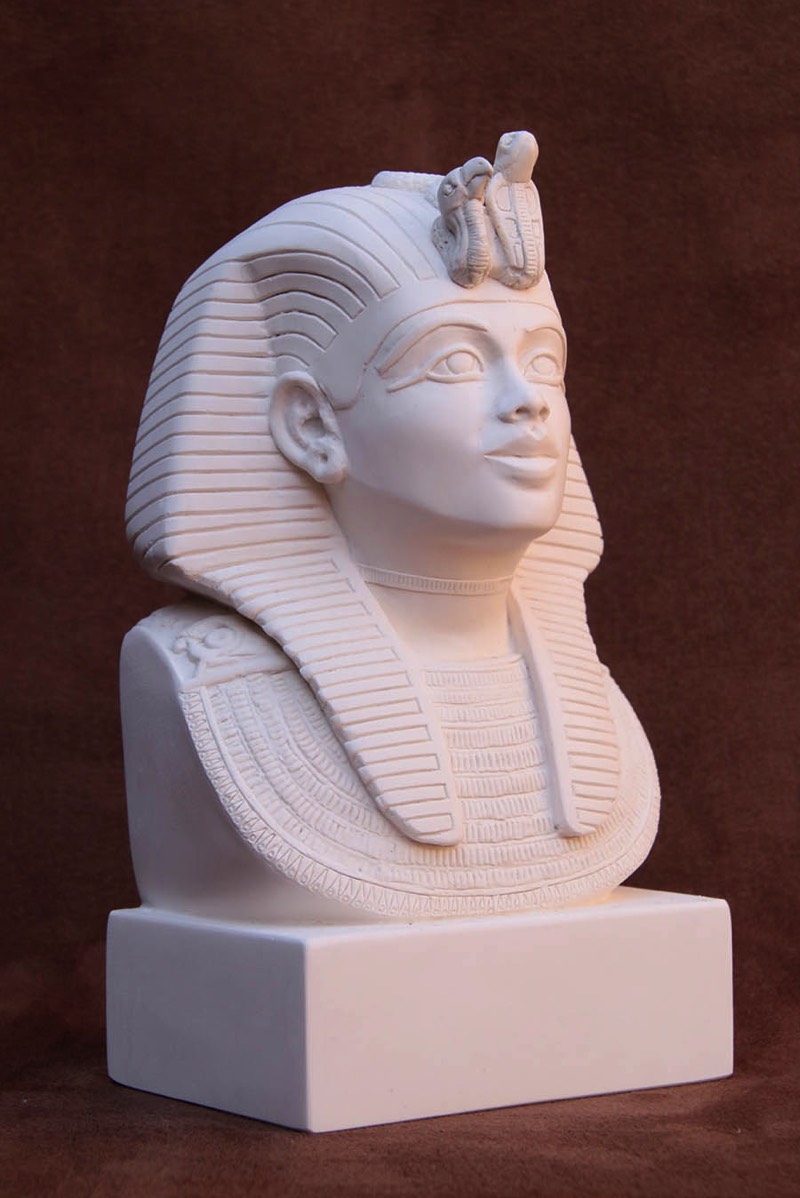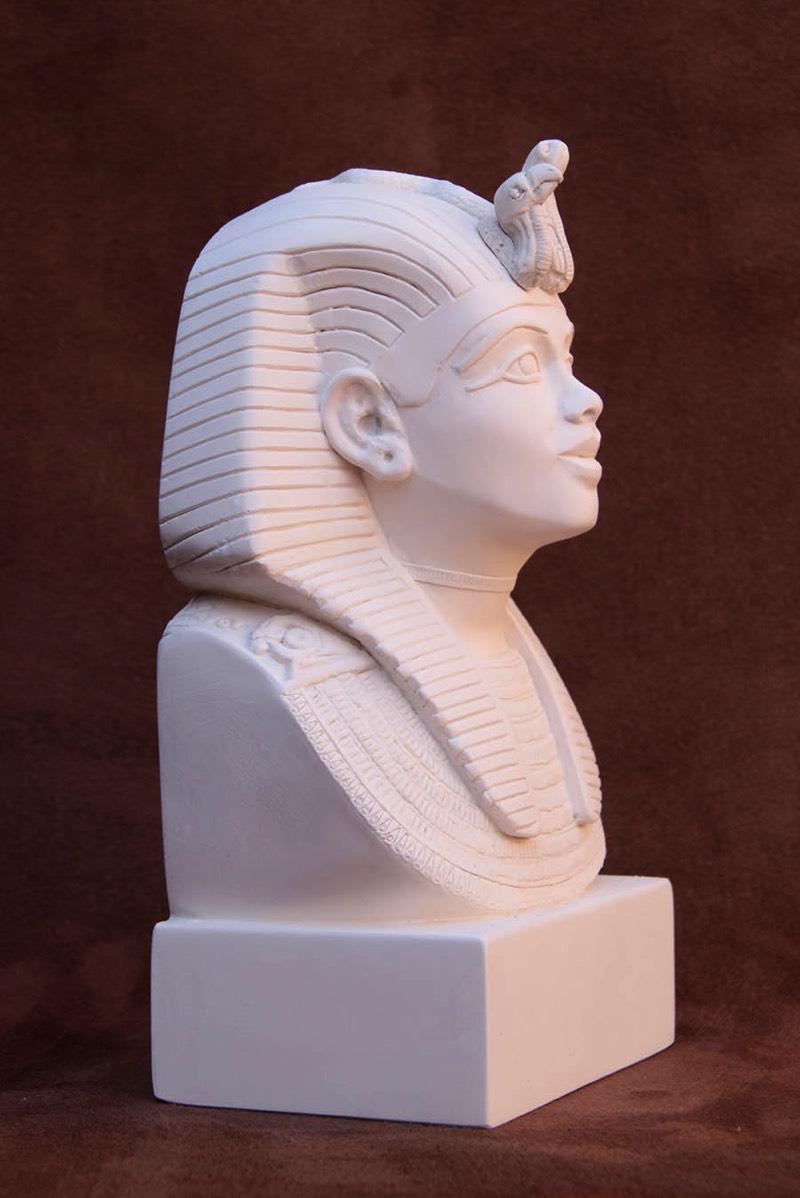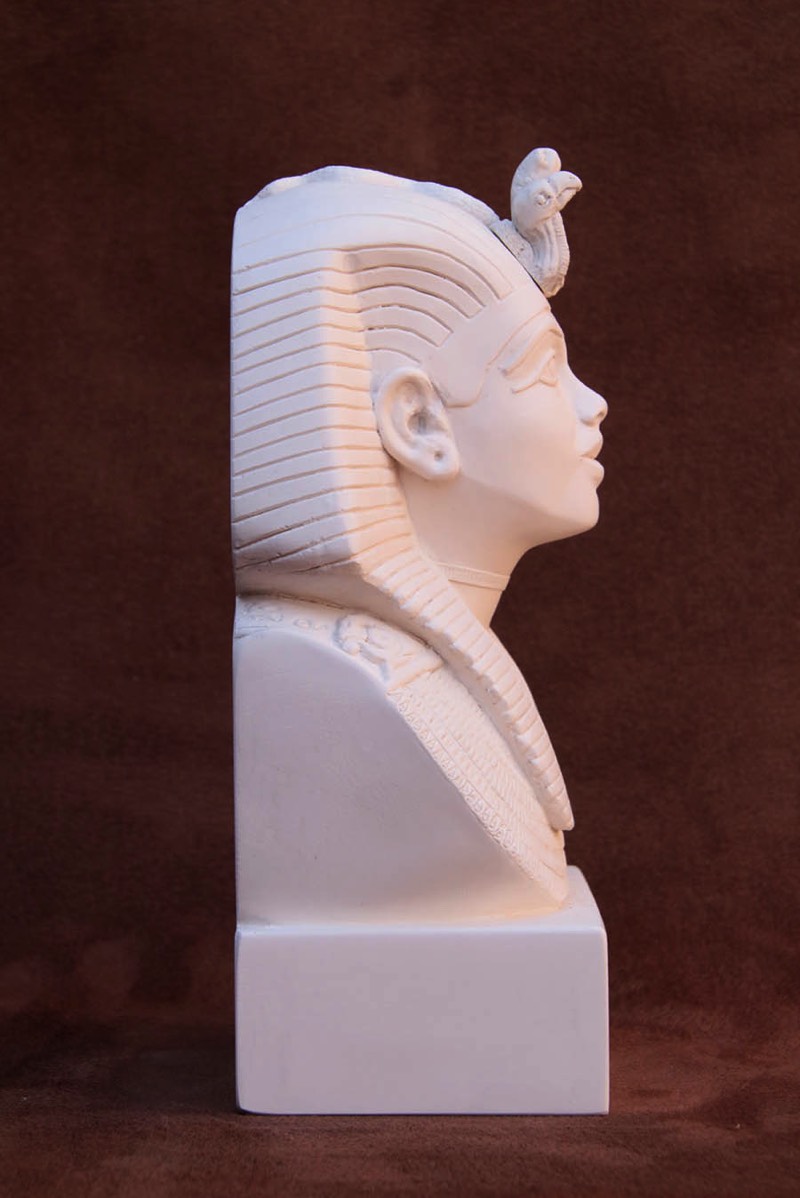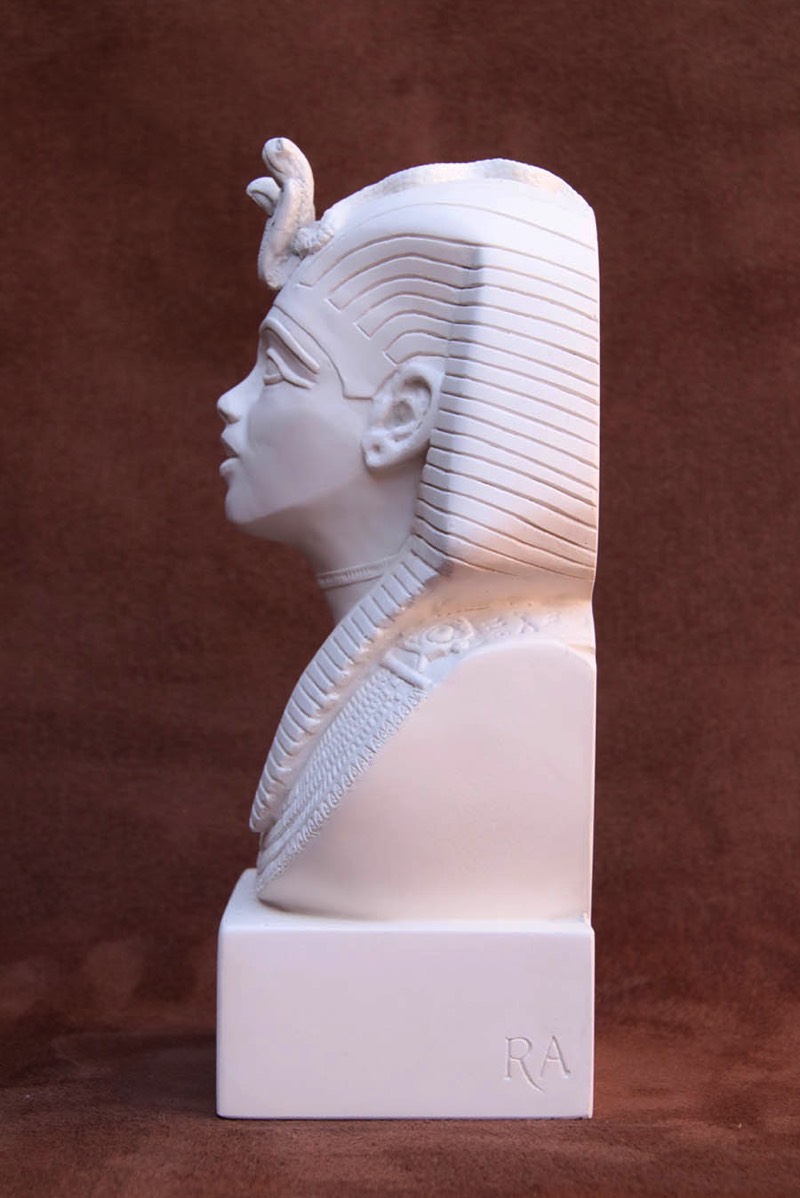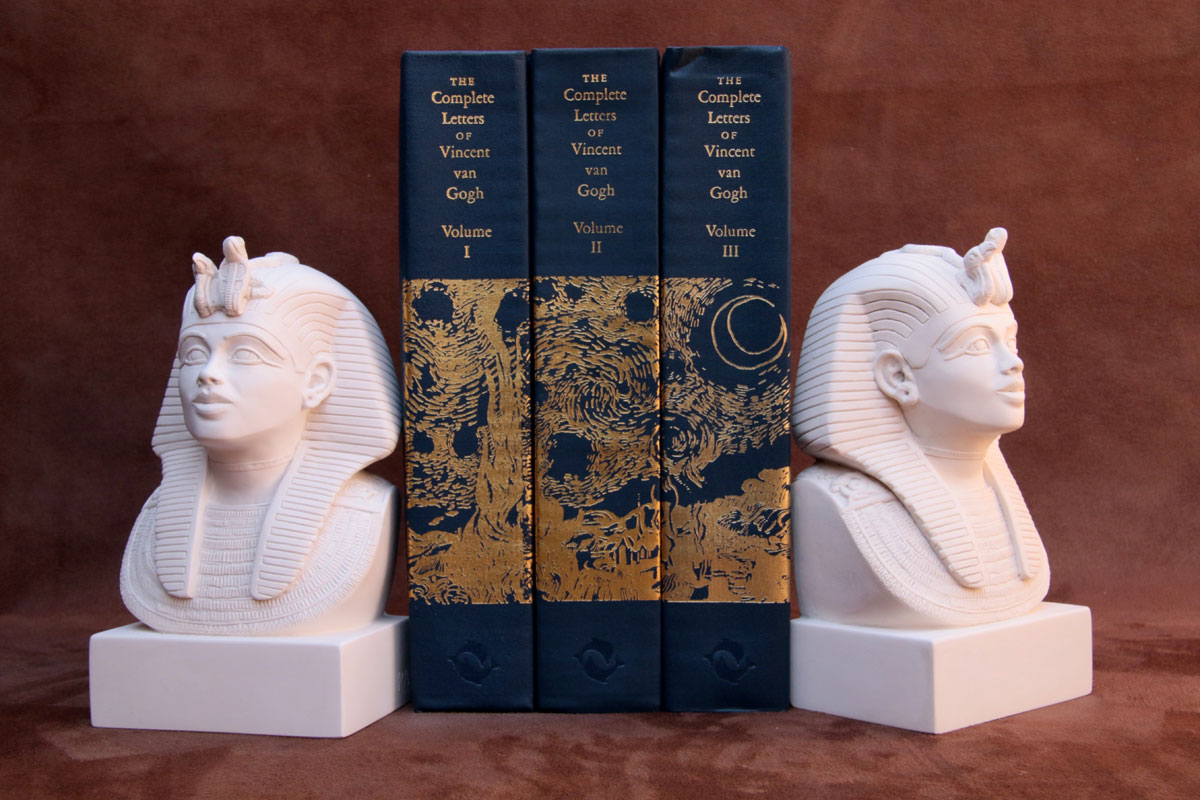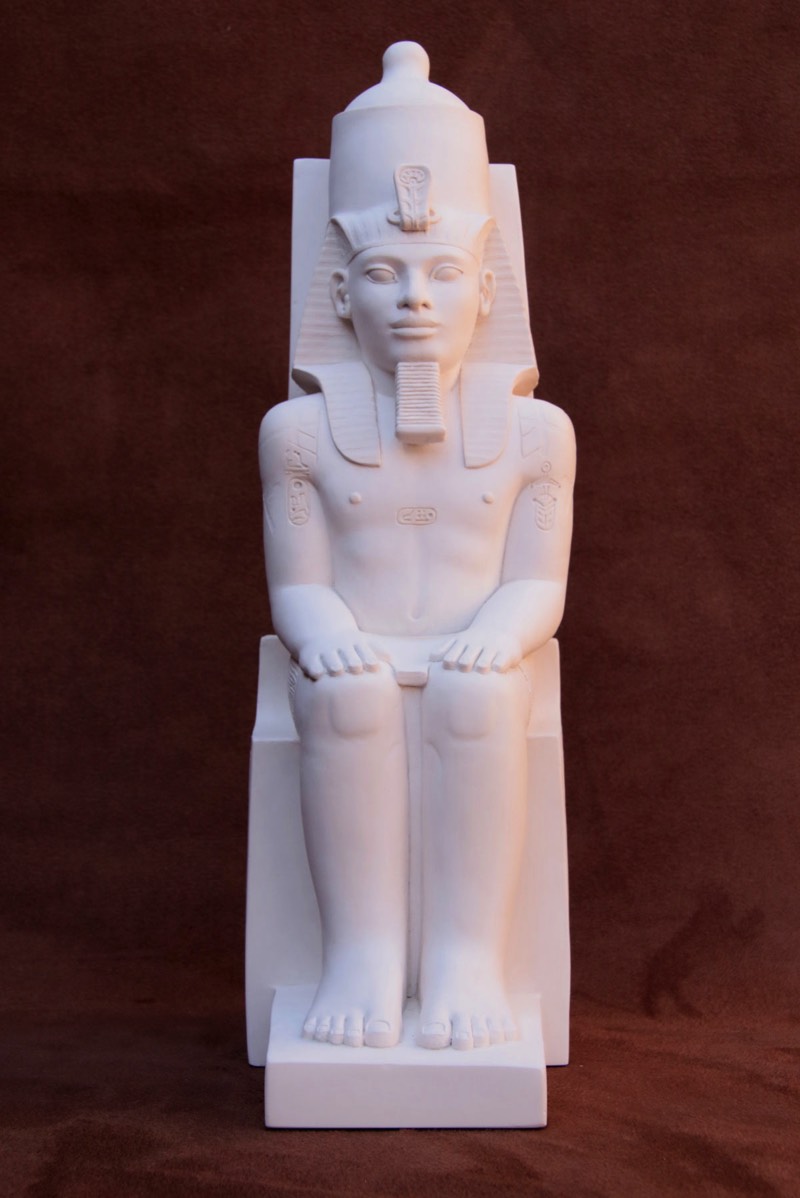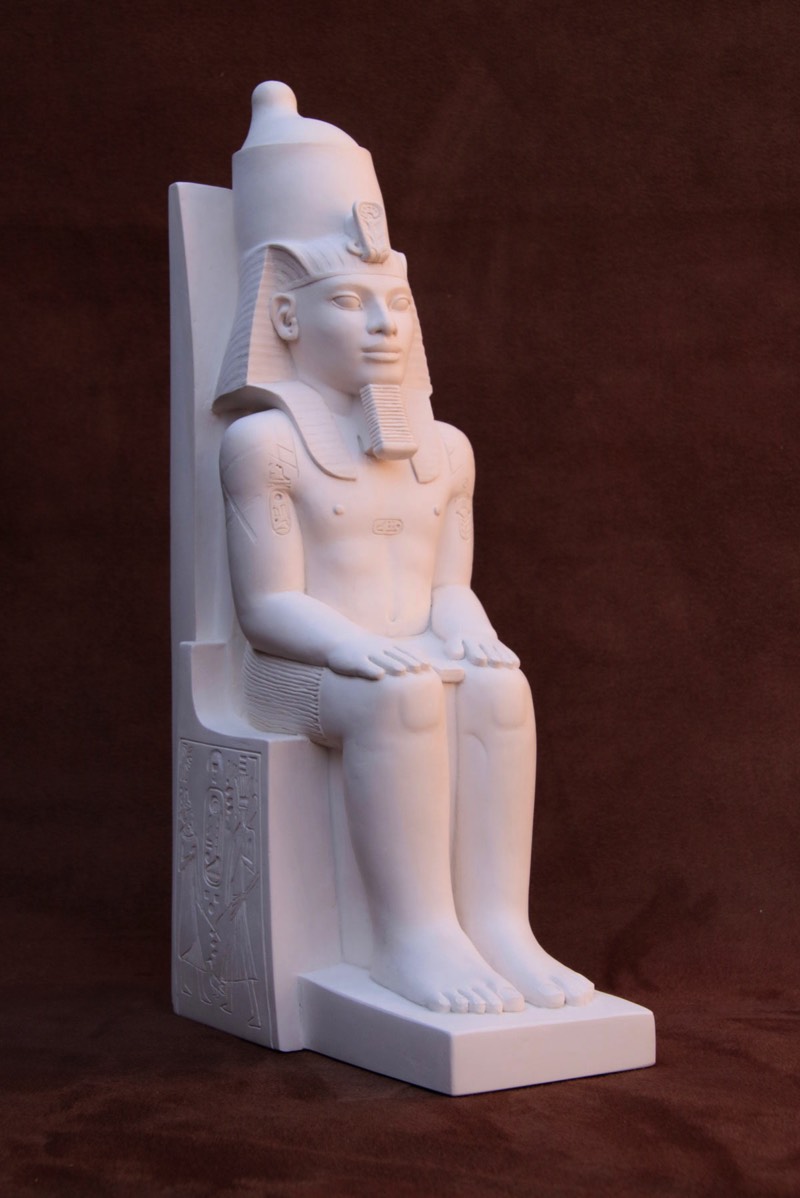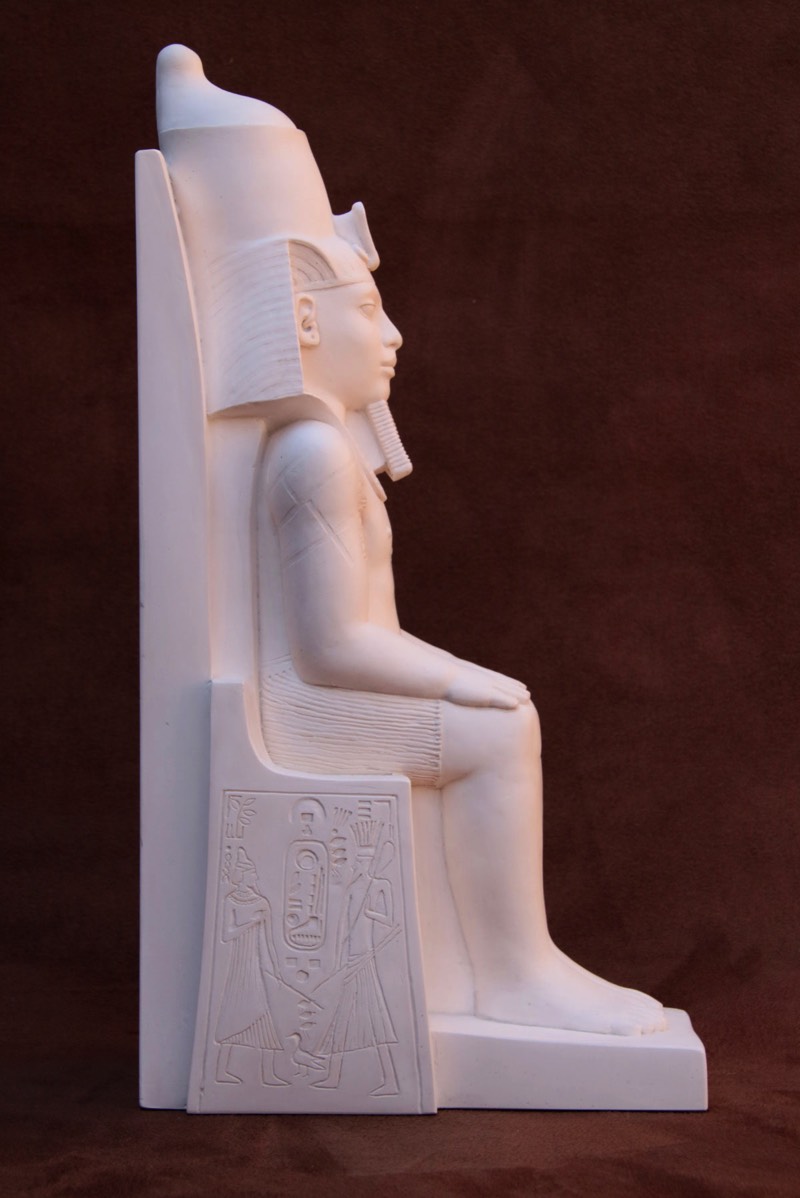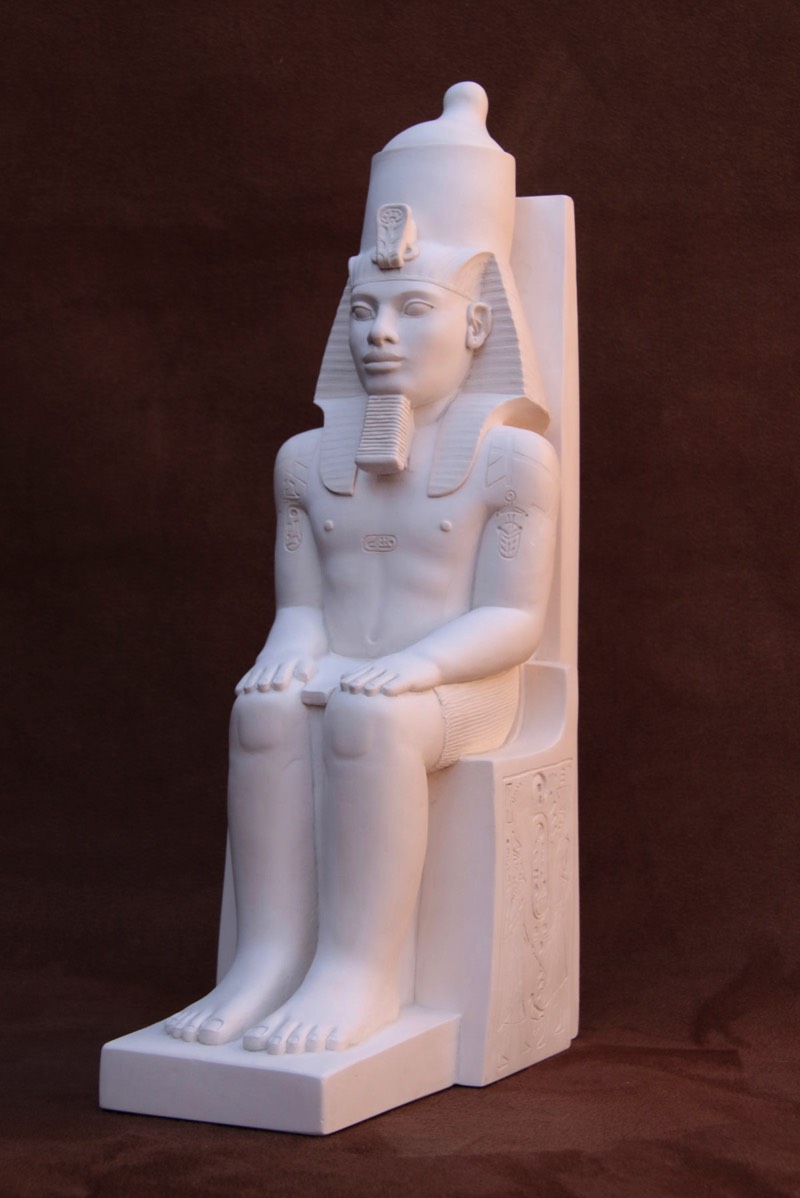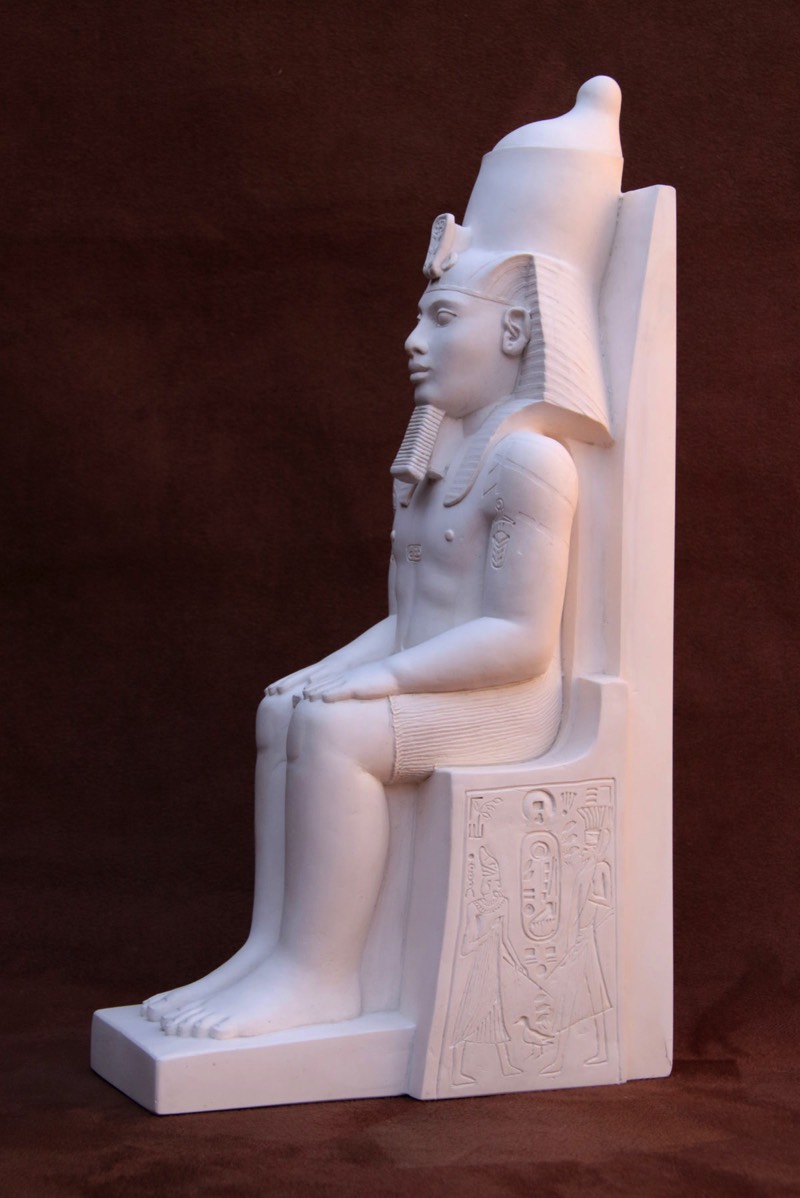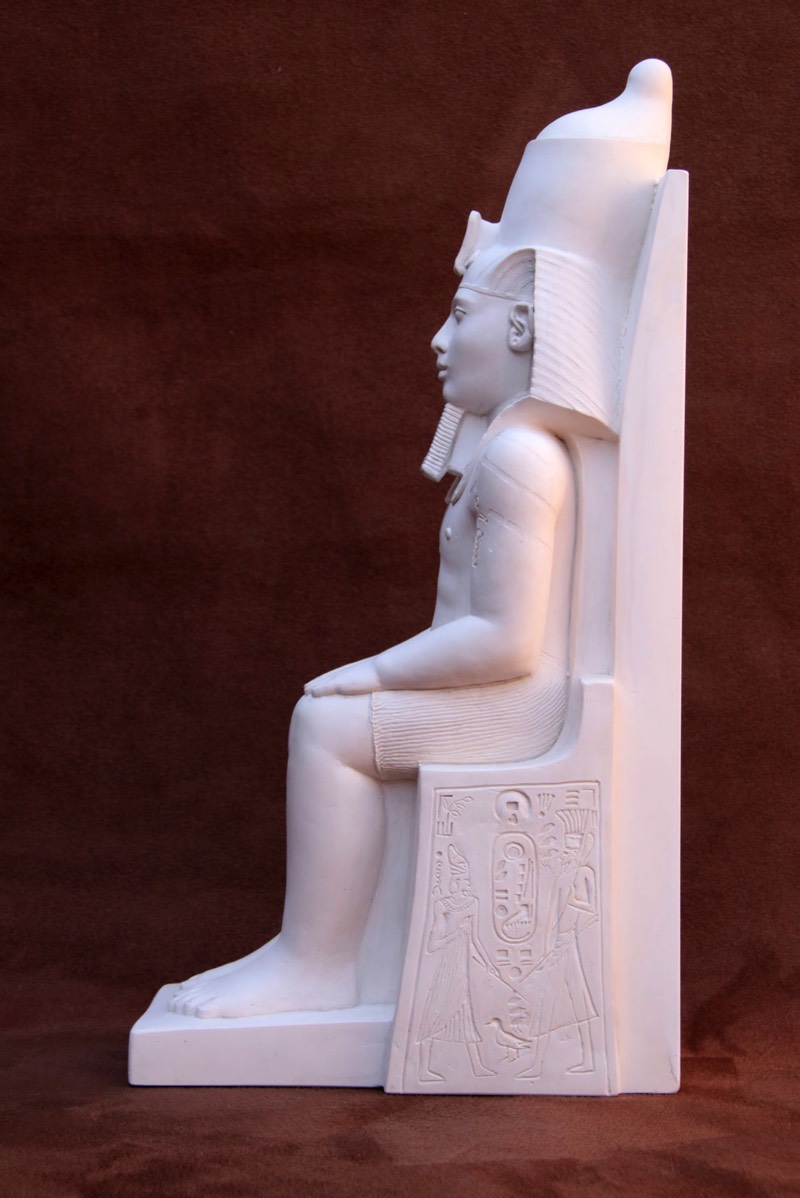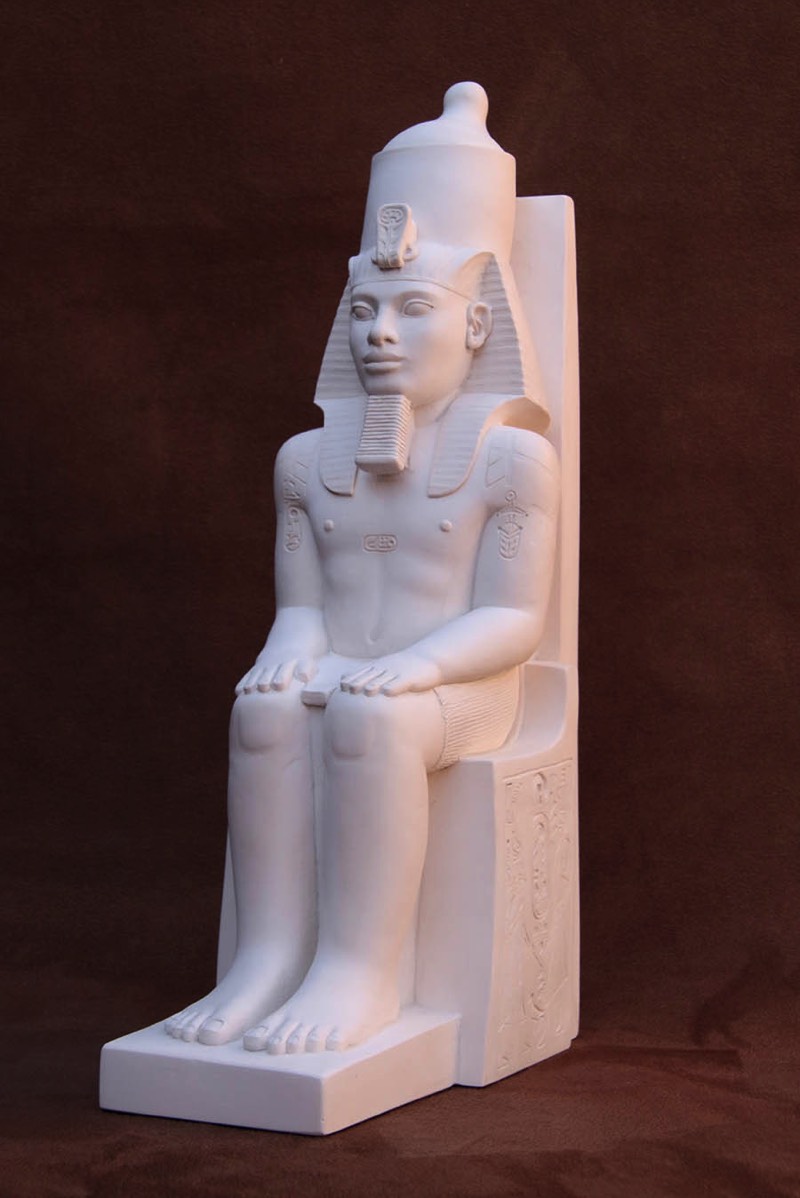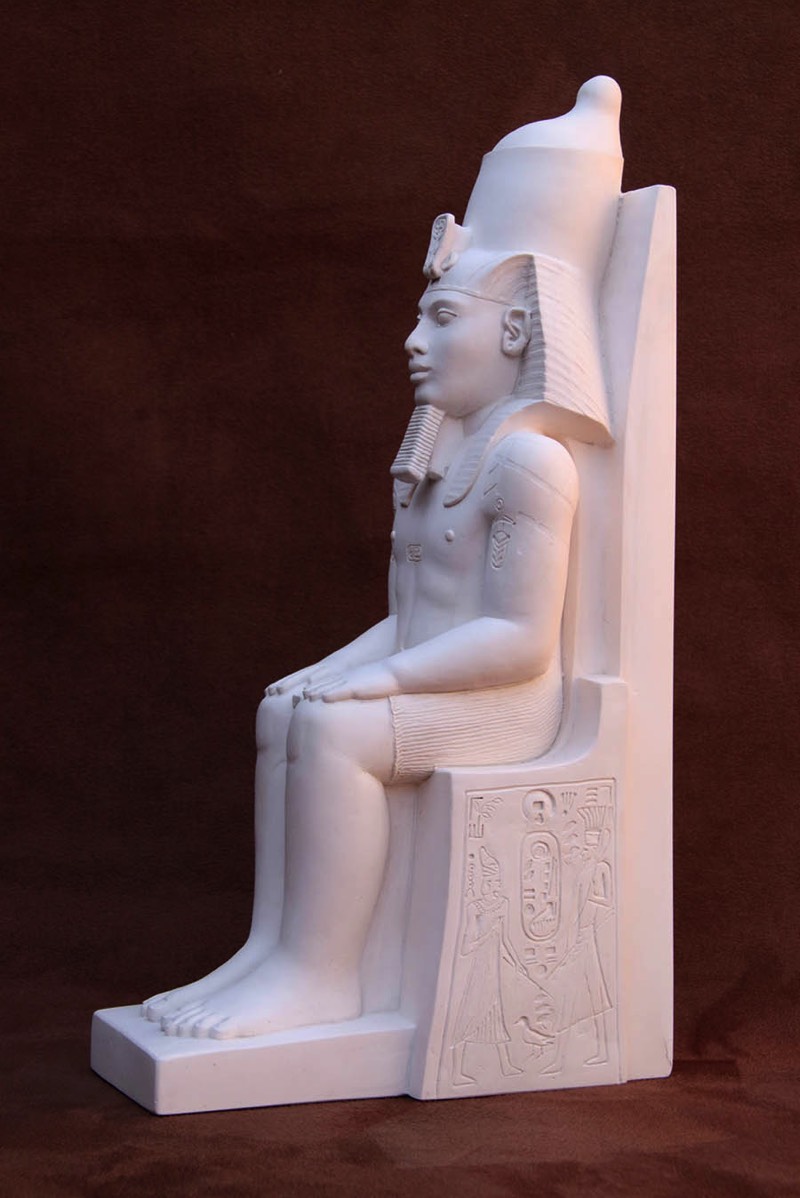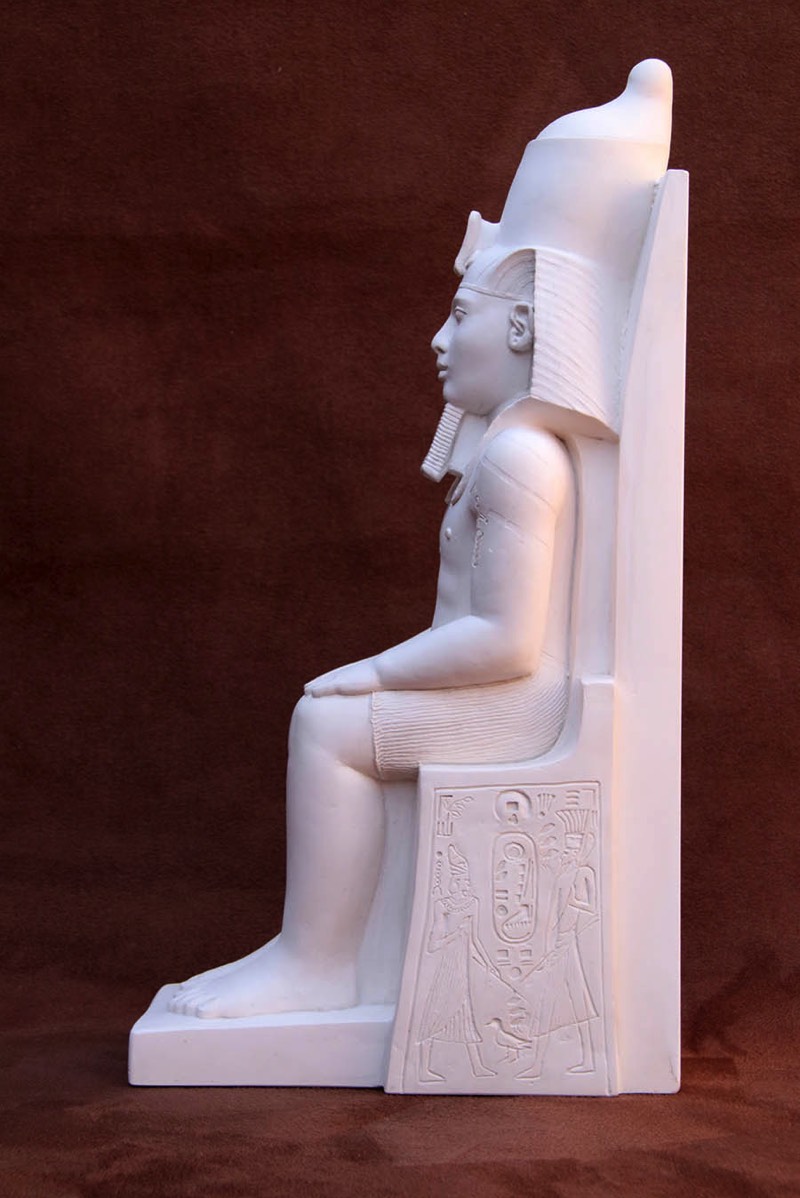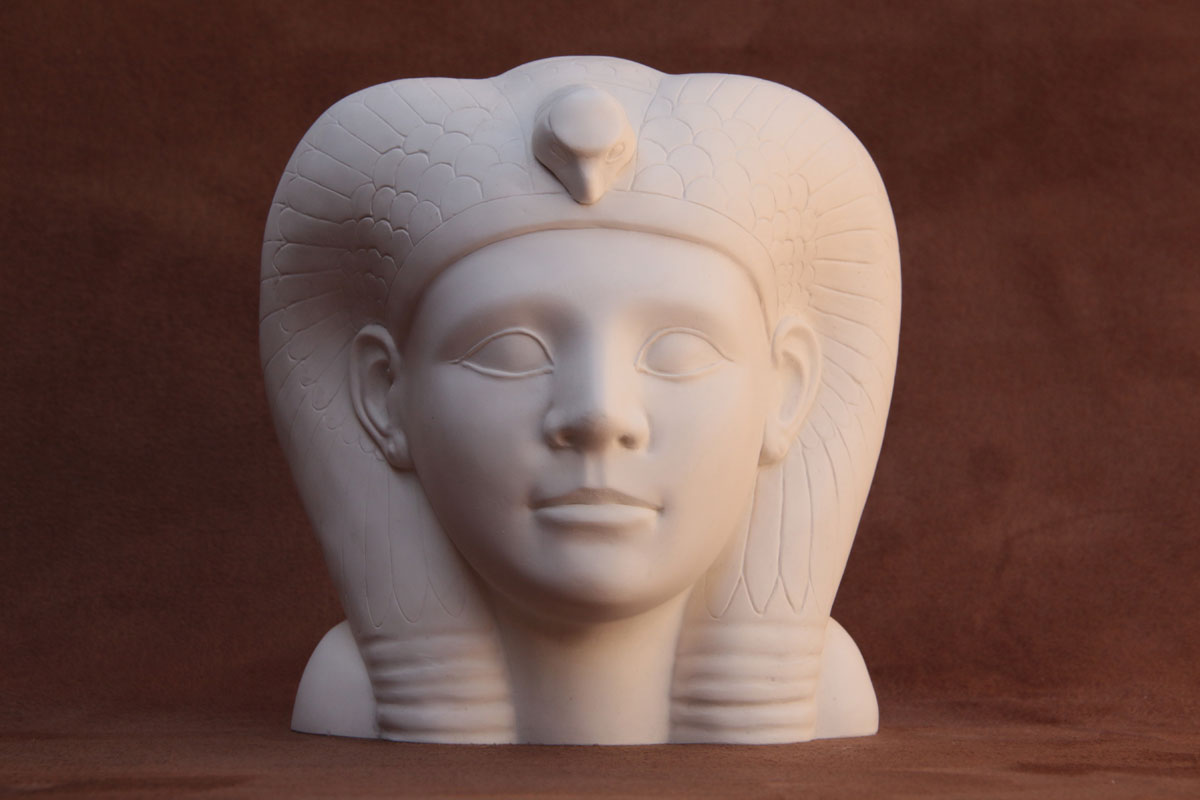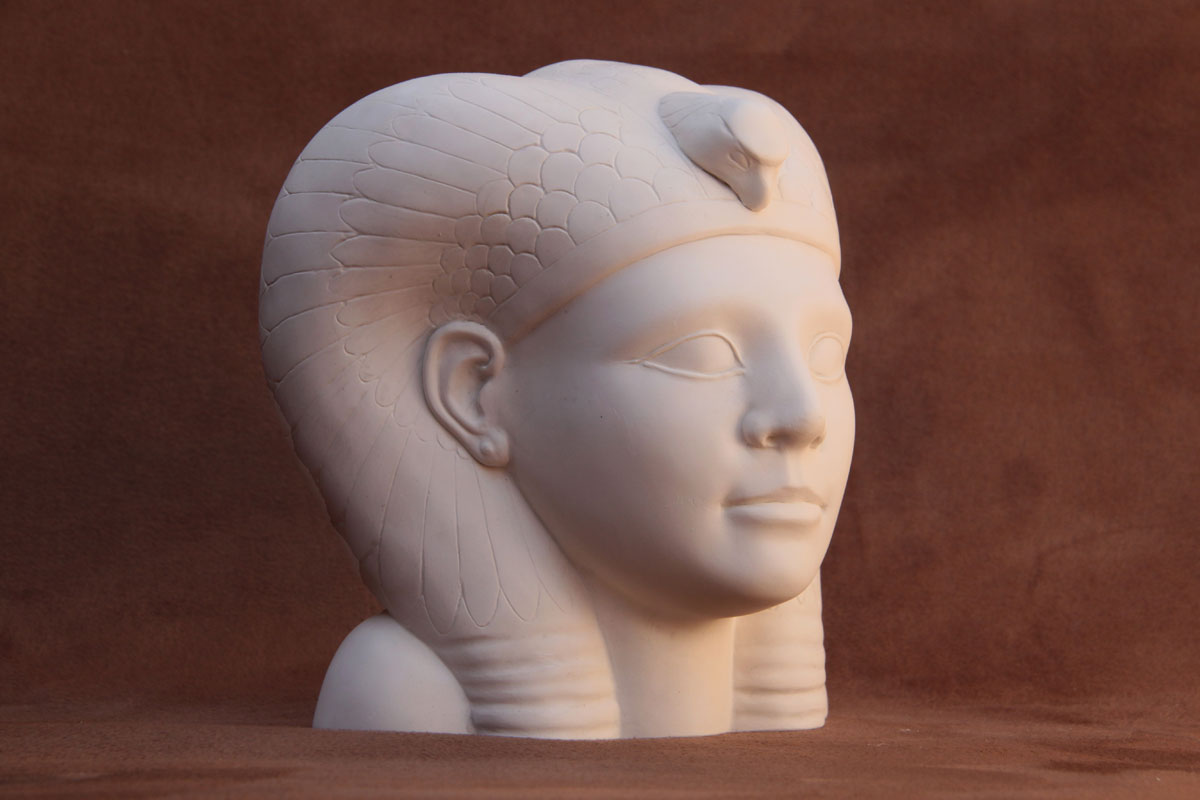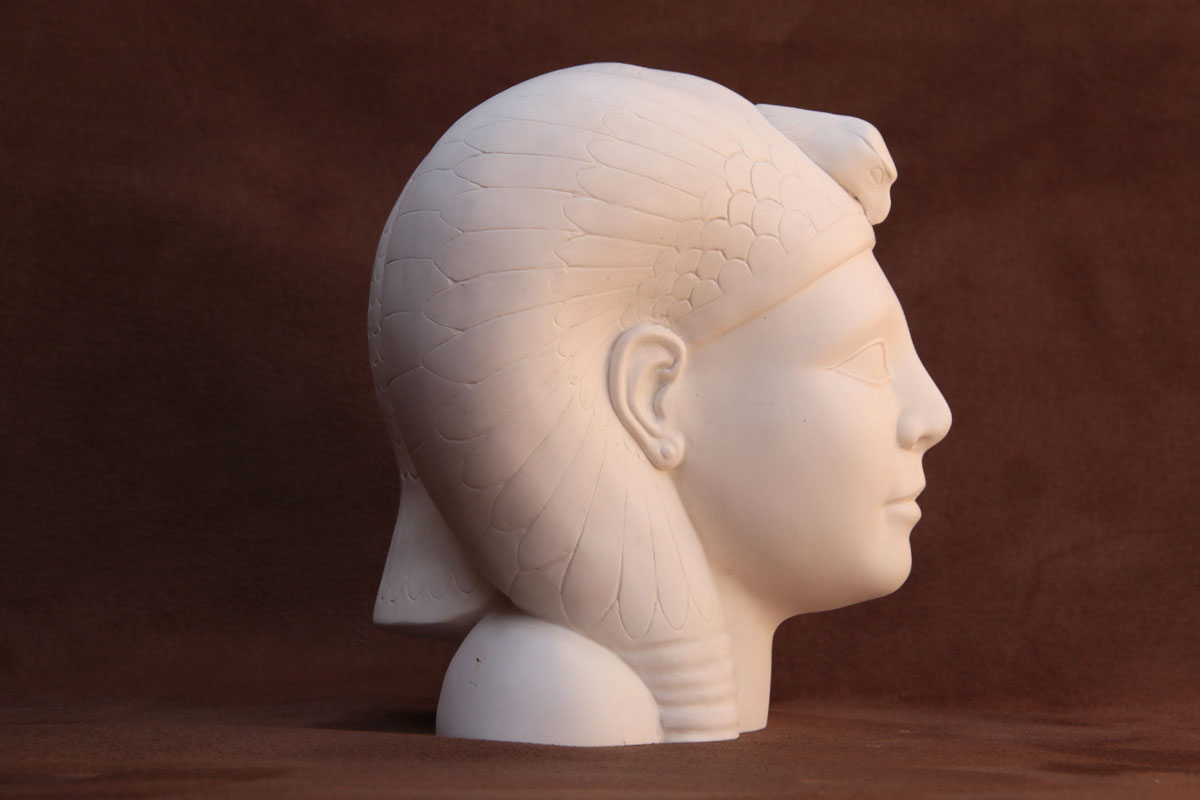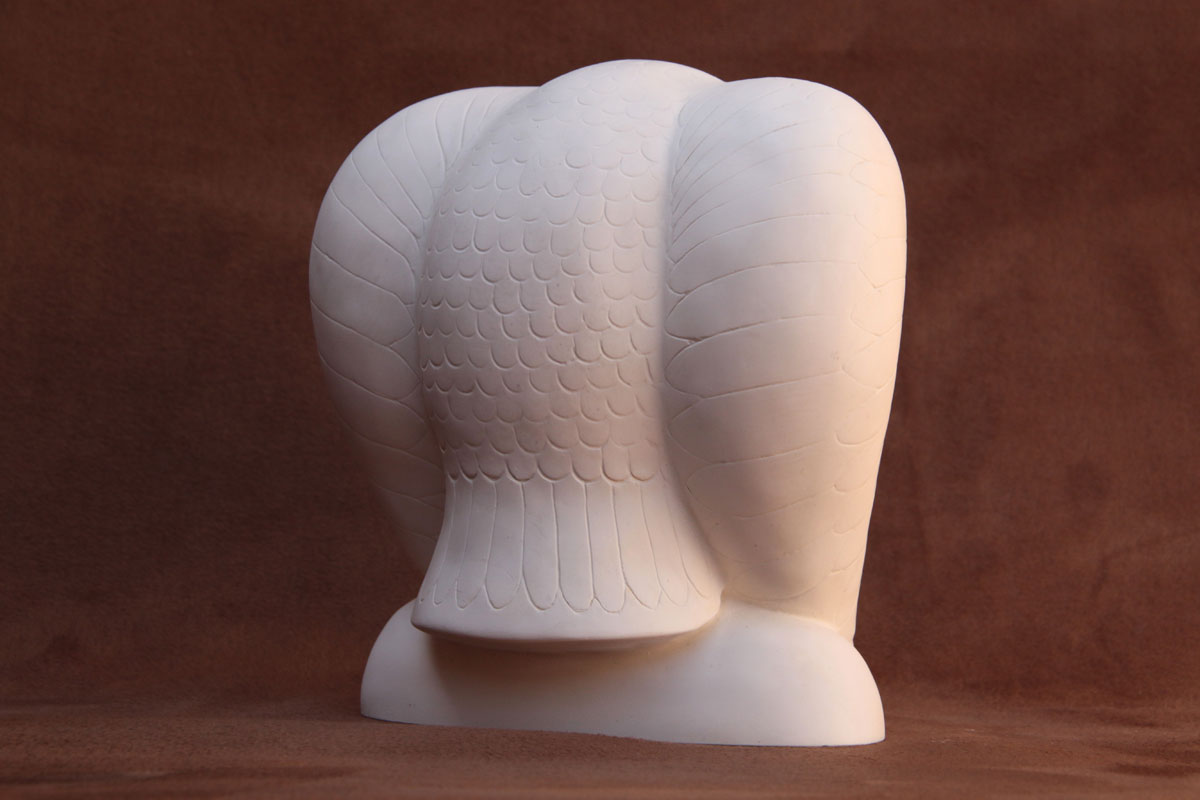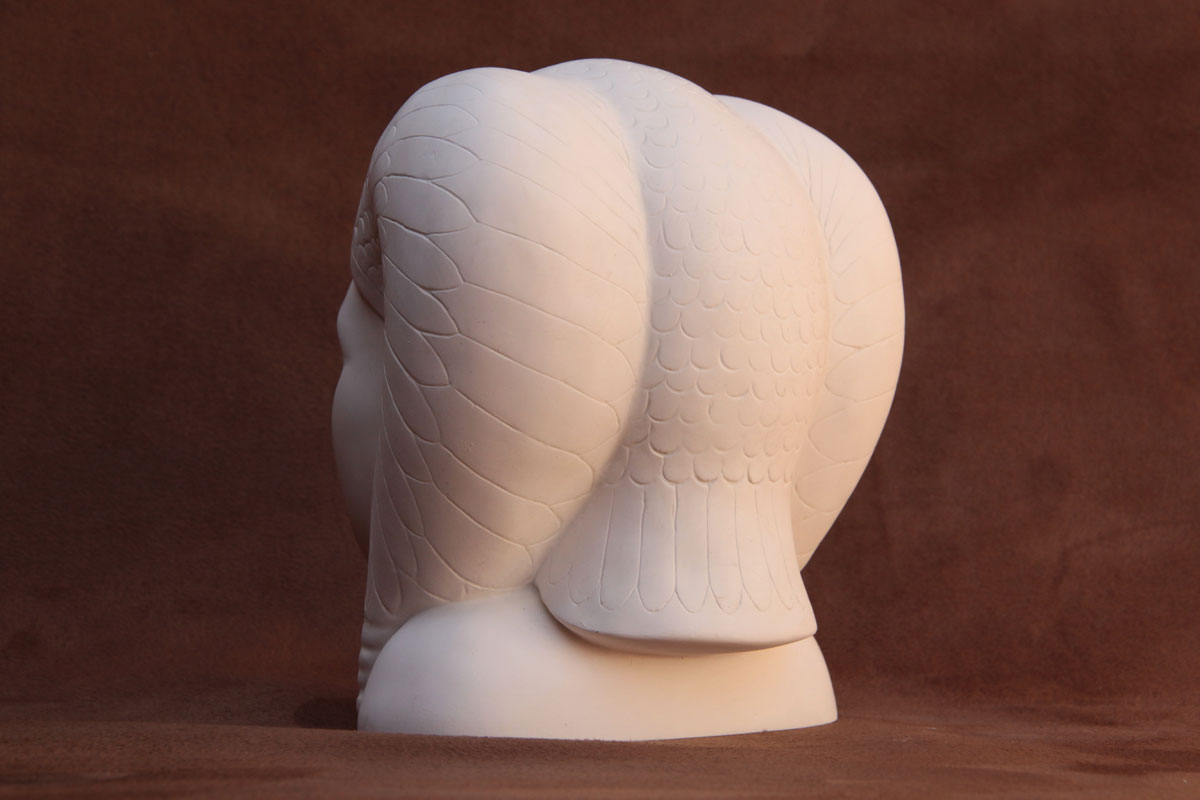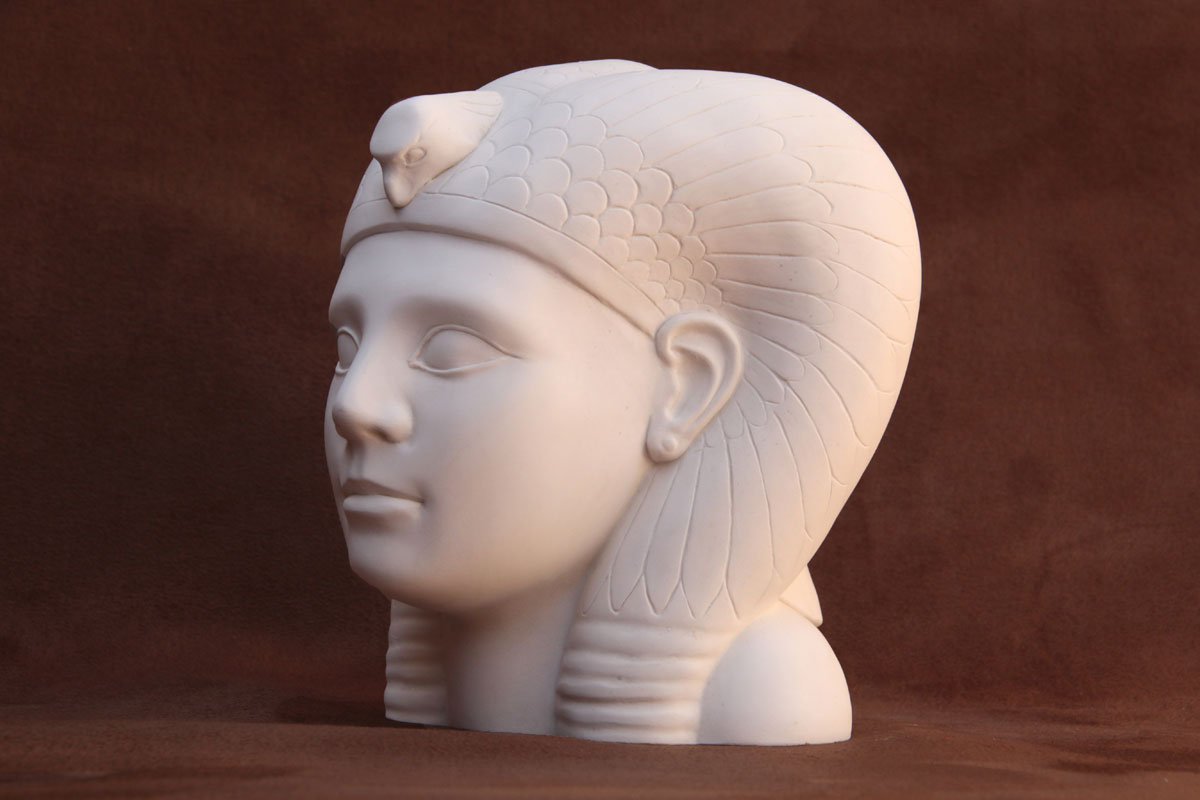
Egyptian Pharaohs & Queens Collection
Click on the image to enlarge.
Cleopatra
51 - 30 BC
Cleopatra ruled Egypt from 51 to 30 BC as Egypt’s last pharaoh.
More Info
She was renowned for her beauty, intelligence and political astuteness and remembered for her passionate affairs with Julius Caesar and Mark Antony.
The etch around the base reads:
"AGE CANNOT WITHER HER, NOT CUSTOM STALE HER INFINiTE VARIETY"
Height: 130mm
Width: 70mm
Depth: 35mm
The etch around the base reads:
"AGE CANNOT WITHER HER, NOT CUSTOM STALE HER INFINiTE VARIETY"
Height: 130mm
Width: 70mm
Depth: 35mm
Click on the image to enlarge.
Nefertiti Queen of Egypt
This is a copy of the famous bust of Nefertiti
More Info
that can be seen in the Egyptian Museum in Berlin. This piece is made from British gypsum plaster, whereas the original is made from limestone and stucco and is beautifully painted.
Height: 160mm
Width: 60mm
Depth: 100mm
Height: 160mm
Width: 60mm
Depth: 100mm
Click on the image to enlarge.
Mask of Tutankhamun
(Ornament or Bookend Single)
The 1922 discovery by Howard Carter and George Herbert, 5th Earl of Carnarvon of Tutankhamun's virtually intact tomb received worldwide press coverage.
More Info
It sparked a renewed public interest in Ancient Egypt, for which Tutankhamun's burial mask remains the popular symbol.
Tutankhamun's tomb was the only burial chamber to be discovered dating from Egypt’s New Kingdom (c1550–1069 BC) to have been found substantially intact.
The contents provided an unequalled insight into royal funerary practices, art and craftsmanship of the period.
Height: 180mm
Width: 100mm
Depth: 70mm
Tutankhamun's tomb was the only burial chamber to be discovered dating from Egypt’s New Kingdom (c1550–1069 BC) to have been found substantially intact.
The contents provided an unequalled insight into royal funerary practices, art and craftsmanship of the period.
Height: 180mm
Width: 100mm
Depth: 70mm
Click on the image to enlarge.
Mask of Tutankhamun
Bookends (Set of 2)
The 1922 discovery by Howard Carter and George Herbert, 5th Earl of Carnarvon of Tutankhamun's virtually intact tomb received worldwide press coverage.
Bookends (Set of 2)
The 1922 discovery by Howard Carter and George Herbert, 5th Earl of Carnarvon of Tutankhamun's virtually intact tomb received worldwide press coverage.
More Info
It sparked a renewed public interest in Ancient Egypt, for which Tutankhamun's burial mask remains the popular symbol.
Tutankhamun's tomb was the only burial chamber to be discovered dating from Egypt’s New Kingdom (c1550–1069 BC) to have been found substantially intact.
The contents provided an unequalled insight into royal funerary practices, art and craftsmanship of the period.
Dimensions each:
Height: 180mm
Width: 100mm
Depth: 70mm
Tutankhamun's tomb was the only burial chamber to be discovered dating from Egypt’s New Kingdom (c1550–1069 BC) to have been found substantially intact.
The contents provided an unequalled insight into royal funerary practices, art and craftsmanship of the period.
Dimensions each:
Height: 180mm
Width: 100mm
Depth: 70mm
Rameses II the Great (Bookend Single)
Was the third Egyptian Pharaoh (reigned 1279 BC – 1213 BC) of the Nineteenth dynasty.
More Info
He is often regarded as the greatest, most celebrated, and most powerful Pharaoh of the Egyptian Empire and successors and later Egyptians called him the "Great Ancestor." Rameses was aged 25 when he ascended the throne and ruled Egypt for 67 years.
When in his thirtieth year of ruling he was promoted to a living god, Rameses wanted the buildings to reflect his status. Among the most notable structures he created are those at the Great Temple of Abu Simbel, where Rameses sits next to his fellow gods Amun, Ra-Horakhty, and Ptah.
This exquisite sculpture is a replica of the seated Rameses statue which was at the door of the Temple. The original statue is located in the ancient Wawat (or the legendary Ybsambul) in Nubia, near the borders of Sudan.
The sculpture shows an idealised image of Rameses as a young man, with high cheek-bones and smooth skin. His eyebrows arch gently over wide, almond-shaped eyes. His nose is straight and well- defined and his full lips are set in a serene smile. Jutting below his chin is the rectangular false beard traditionally worn by royalty.
Rameses also wears the nemes or royal head-dress. The stone head-dress of the statue is surmounted by a diadem or headband in the shape of a uraeus - a rearing cobra and on top of his head Rameses wears a modus crown.
Height: 320mm
Width: 95mm
Depth: 140mm
When in his thirtieth year of ruling he was promoted to a living god, Rameses wanted the buildings to reflect his status. Among the most notable structures he created are those at the Great Temple of Abu Simbel, where Rameses sits next to his fellow gods Amun, Ra-Horakhty, and Ptah.
This exquisite sculpture is a replica of the seated Rameses statue which was at the door of the Temple. The original statue is located in the ancient Wawat (or the legendary Ybsambul) in Nubia, near the borders of Sudan.
The sculpture shows an idealised image of Rameses as a young man, with high cheek-bones and smooth skin. His eyebrows arch gently over wide, almond-shaped eyes. His nose is straight and well- defined and his full lips are set in a serene smile. Jutting below his chin is the rectangular false beard traditionally worn by royalty.
Rameses also wears the nemes or royal head-dress. The stone head-dress of the statue is surmounted by a diadem or headband in the shape of a uraeus - a rearing cobra and on top of his head Rameses wears a modus crown.
Height: 320mm
Width: 95mm
Depth: 140mm
Click on the image to enlarge.
Rameses II the Great (set of two)
Was the third Egyptian Pharaoh (reigned 1279 BC – 1213 BC) of the Nineteenth dynasty.
Was the third Egyptian Pharaoh (reigned 1279 BC – 1213 BC) of the Nineteenth dynasty.
More Info
He is often regarded as the greatest, most celebrated, and most powerful Pharaoh of the Egyptian Empire and successors and later Egyptians called him the "Great Ancestor." Rameses was aged 25 when he ascended the throne and ruled Egypt for 67 years.
When in his thirtieth year of ruling he was promoted to a living god, Rameses wanted the buildings to reflect his status. Among the most notable structures he created are those at the Great Temple of Abu Simbel, where Rameses sits next to his fellow gods Amun, Ra-Horakhty, and Ptah.
This exquisite sculpture is a replica of the seated Rameses statue which was at the door of the Temple. The original statue is located in the ancient Wawat (or the legendary Ybsambul) in Nubia, near the borders of Sudan.
The sculpture shows an idealised image of Rameses as a young man, with high cheek-bones and smooth skin. His eyebrows arch gently over wide, almond-shaped eyes. His nose is straight and well- defined and his full lips are set in a serene smile. Jutting below his chin is the rectangular false beard traditionally worn by royalty.
Rameses also wears the nemes or royal head-dress. The stone head-dress of the statue is surmounted by a diadem or headband in the shape of a uraeus - a rearing cobra and on top of his head Rameses wears a modus crown.
Height: 320mm
Width: 95mm
Depth: 140mm
When in his thirtieth year of ruling he was promoted to a living god, Rameses wanted the buildings to reflect his status. Among the most notable structures he created are those at the Great Temple of Abu Simbel, where Rameses sits next to his fellow gods Amun, Ra-Horakhty, and Ptah.
This exquisite sculpture is a replica of the seated Rameses statue which was at the door of the Temple. The original statue is located in the ancient Wawat (or the legendary Ybsambul) in Nubia, near the borders of Sudan.
The sculpture shows an idealised image of Rameses as a young man, with high cheek-bones and smooth skin. His eyebrows arch gently over wide, almond-shaped eyes. His nose is straight and well- defined and his full lips are set in a serene smile. Jutting below his chin is the rectangular false beard traditionally worn by royalty.
Rameses also wears the nemes or royal head-dress. The stone head-dress of the statue is surmounted by a diadem or headband in the shape of a uraeus - a rearing cobra and on top of his head Rameses wears a modus crown.
Height: 320mm
Width: 95mm
Depth: 140mm
Click on the image to enlarge.
Queens Head / Ornament & Bookend Single
This is a copy of an Egyptian Head sculpture. The original can be seen at the Burrell Collection in Glasgow, Scotland.
This is a copy of an Egyptian Head sculpture. The original can be seen at the Burrell Collection in Glasgow, Scotland.
More Info
Sir William Burrell (1861-1958) was a wealthy Glasgow ship owner and he and his wife, Constance, Lady Burrell gifted his collection of over 9,000 works of art to Glasgow in 1944.
Burrell established his collection of art and artefacts over many years. This Egyptian sculpture like many of his acquisitions was bought from a dealer on the antiquities market and therefore has no provenance history.
Although we have no provenance, the piece itself gives some clues as to its history. The original sculpture is black in colour, most likely made of black Basalt, a popular material of the period.
The subject of the sculpture wears a "Vulture Cap", an item synonymous with sovereignty in Ancient Egypt. In Egyptian mythology, vultures were symbols of femininity and maternal protection. The headdress, worn by the Queens of Ancient Egypt has associations with Nekhbet, the patron of the Pharaoh and later Mut, the maternal goddess.
Other features of the head are the scroll and Hathor wigs which were popularly worn by Queens in the late 18th Dynasty, which is around the same period the curators of The Burrell Collection date the piece, circa 1400 BC.
Height: 195mm
Width: 155mm
Depth: 155mm
Burrell established his collection of art and artefacts over many years. This Egyptian sculpture like many of his acquisitions was bought from a dealer on the antiquities market and therefore has no provenance history.
Although we have no provenance, the piece itself gives some clues as to its history. The original sculpture is black in colour, most likely made of black Basalt, a popular material of the period.
The subject of the sculpture wears a "Vulture Cap", an item synonymous with sovereignty in Ancient Egypt. In Egyptian mythology, vultures were symbols of femininity and maternal protection. The headdress, worn by the Queens of Ancient Egypt has associations with Nekhbet, the patron of the Pharaoh and later Mut, the maternal goddess.
Other features of the head are the scroll and Hathor wigs which were popularly worn by Queens in the late 18th Dynasty, which is around the same period the curators of The Burrell Collection date the piece, circa 1400 BC.
Height: 195mm
Width: 155mm
Depth: 155mm
Egyptian Pharaohs & Queens Collection
Click on the image to enlarge.
Cleopatra
51 - 30 BC
Cleopatra ruled Egypt from 51 to 30 BC as Egypt’s last pharaoh.
More Info
She was renowned for her beauty, intelligence and political astuteness and remembered for her passionate affairs with Julius Caesar and Mark Antony.
The etch around the base reads:
"AGE CANNOT WITHER HER, NOT CUSTOM STALE HER INFINiTE VARIETY"
Height: 130mm
Width: 70mm
Depth: 35mm
The etch around the base reads:
"AGE CANNOT WITHER HER, NOT CUSTOM STALE HER INFINiTE VARIETY"
Height: 130mm
Width: 70mm
Depth: 35mm
Click on the image to enlarge.
Nefertiti Queen of Egypt
This is a copy of the famous bust of Nefertiti
More Info
that can be seen in the Egyptian Museum in Berlin. This piece is made from British gypsum plaster, whereas the original is made from limestone and stucco and is beautifully painted.
Height: 160mm
Width: 60mm
Depth: 100mm
Height: 160mm
Width: 60mm
Depth: 100mm
Click on the image to enlarge.
Mask of Tutankhamun
(Ornament or Bookend Single)
The 1922 discovery by Howard Carter and George Herbert, 5th Earl of Carnarvon of Tutankhamun's virtually intact tomb received worldwide press coverage.
More Info
It sparked a renewed public interest in Ancient Egypt, for which Tutankhamun's burial mask remains the popular symbol.
Tutankhamun's tomb was the only burial chamber to be discovered dating from Egypt’s New Kingdom (c1550–1069 BC) to have been found substantially intact.
The contents provided an unequalled insight into royal funerary practices, art and craftsmanship of the period.
Height: 180mm
Width: 100mm
Depth: 70mm
Tutankhamun's tomb was the only burial chamber to be discovered dating from Egypt’s New Kingdom (c1550–1069 BC) to have been found substantially intact.
The contents provided an unequalled insight into royal funerary practices, art and craftsmanship of the period.
Height: 180mm
Width: 100mm
Depth: 70mm
Click on the image to enlarge.
Mask of Tutankhamun
Bookends (Set of 2)
The 1922 discovery by Howard Carter and George Herbert, 5th Earl of Carnarvon of Tutankhamun's virtually intact tomb received worldwide press coverage.
Bookends (Set of 2)
The 1922 discovery by Howard Carter and George Herbert, 5th Earl of Carnarvon of Tutankhamun's virtually intact tomb received worldwide press coverage.
More Info
It sparked a renewed public interest in Ancient Egypt, for which Tutankhamun's burial mask remains the popular symbol.
Tutankhamun's tomb was the only burial chamber to be discovered dating from Egypt’s New Kingdom (c1550–1069 BC) to have been found substantially intact.
The contents provided an unequalled insight into royal funerary practices, art and craftsmanship of the period.
Dimensions each:
Height: 180mm
Width: 100mm
Depth: 70mm
Tutankhamun's tomb was the only burial chamber to be discovered dating from Egypt’s New Kingdom (c1550–1069 BC) to have been found substantially intact.
The contents provided an unequalled insight into royal funerary practices, art and craftsmanship of the period.
Dimensions each:
Height: 180mm
Width: 100mm
Depth: 70mm
Rameses II the Great (Bookend Single)
Was the third Egyptian Pharaoh (reigned 1279 BC – 1213 BC) of the Nineteenth dynasty.
More Info
He is often regarded as the greatest, most celebrated, and most powerful Pharaoh of the Egyptian Empire and successors and later Egyptians called him the "Great Ancestor." Rameses was aged 25 when he ascended the throne and ruled Egypt for 67 years.
When in his thirtieth year of ruling he was promoted to a living god, Rameses wanted the buildings to reflect his status. Among the most notable structures he created are those at the Great Temple of Abu Simbel, where Rameses sits next to his fellow gods Amun, Ra-Horakhty, and Ptah.
This exquisite sculpture is a replica of the seated Rameses statue which was at the door of the Temple. The original statue is located in the ancient Wawat (or the legendary Ybsambul) in Nubia, near the borders of Sudan.
The sculpture shows an idealised image of Rameses as a young man, with high cheek-bones and smooth skin. His eyebrows arch gently over wide, almond-shaped eyes. His nose is straight and well- defined and his full lips are set in a serene smile. Jutting below his chin is the rectangular false beard traditionally worn by royalty.
Rameses also wears the nemes or royal head-dress. The stone head-dress of the statue is surmounted by a diadem or headband in the shape of a uraeus - a rearing cobra and on top of his head Rameses wears a modus crown.
Height: 320mm
Width: 95mm
Depth: 140mm
When in his thirtieth year of ruling he was promoted to a living god, Rameses wanted the buildings to reflect his status. Among the most notable structures he created are those at the Great Temple of Abu Simbel, where Rameses sits next to his fellow gods Amun, Ra-Horakhty, and Ptah.
This exquisite sculpture is a replica of the seated Rameses statue which was at the door of the Temple. The original statue is located in the ancient Wawat (or the legendary Ybsambul) in Nubia, near the borders of Sudan.
The sculpture shows an idealised image of Rameses as a young man, with high cheek-bones and smooth skin. His eyebrows arch gently over wide, almond-shaped eyes. His nose is straight and well- defined and his full lips are set in a serene smile. Jutting below his chin is the rectangular false beard traditionally worn by royalty.
Rameses also wears the nemes or royal head-dress. The stone head-dress of the statue is surmounted by a diadem or headband in the shape of a uraeus - a rearing cobra and on top of his head Rameses wears a modus crown.
Height: 320mm
Width: 95mm
Depth: 140mm
Click on the image to enlarge.
Rameses II the Great (set of two)
Was the third Egyptian Pharaoh (reigned 1279 BC – 1213 BC) of the Nineteenth dynasty.
Was the third Egyptian Pharaoh (reigned 1279 BC – 1213 BC) of the Nineteenth dynasty.
More Info
He is often regarded as the greatest, most celebrated, and most powerful Pharaoh of the Egyptian Empire and successors and later Egyptians called him the "Great Ancestor." Rameses was aged 25 when he ascended the throne and ruled Egypt for 67 years.
When in his thirtieth year of ruling he was promoted to a living god, Rameses wanted the buildings to reflect his status. Among the most notable structures he created are those at the Great Temple of Abu Simbel, where Rameses sits next to his fellow gods Amun, Ra-Horakhty, and Ptah.
This exquisite sculpture is a replica of the seated Rameses statue which was at the door of the Temple. The original statue is located in the ancient Wawat (or the legendary Ybsambul) in Nubia, near the borders of Sudan.
The sculpture shows an idealised image of Rameses as a young man, with high cheek-bones and smooth skin. His eyebrows arch gently over wide, almond-shaped eyes. His nose is straight and well- defined and his full lips are set in a serene smile. Jutting below his chin is the rectangular false beard traditionally worn by royalty.
Rameses also wears the nemes or royal head-dress. The stone head-dress of the statue is surmounted by a diadem or headband in the shape of a uraeus - a rearing cobra and on top of his head Rameses wears a modus crown.
Height: 320mm
Width: 95mm
Depth: 140mm
When in his thirtieth year of ruling he was promoted to a living god, Rameses wanted the buildings to reflect his status. Among the most notable structures he created are those at the Great Temple of Abu Simbel, where Rameses sits next to his fellow gods Amun, Ra-Horakhty, and Ptah.
This exquisite sculpture is a replica of the seated Rameses statue which was at the door of the Temple. The original statue is located in the ancient Wawat (or the legendary Ybsambul) in Nubia, near the borders of Sudan.
The sculpture shows an idealised image of Rameses as a young man, with high cheek-bones and smooth skin. His eyebrows arch gently over wide, almond-shaped eyes. His nose is straight and well- defined and his full lips are set in a serene smile. Jutting below his chin is the rectangular false beard traditionally worn by royalty.
Rameses also wears the nemes or royal head-dress. The stone head-dress of the statue is surmounted by a diadem or headband in the shape of a uraeus - a rearing cobra and on top of his head Rameses wears a modus crown.
Height: 320mm
Width: 95mm
Depth: 140mm
Click on the image to enlarge.
Queens Head / Ornament & Bookend Single
This is a copy of an Egyptian Head sculpture. The original can be seen at the Burrell Collection in Glasgow, Scotland.
This is a copy of an Egyptian Head sculpture. The original can be seen at the Burrell Collection in Glasgow, Scotland.
More Info
Sir William Burrell (1861-1958) was a wealthy Glasgow ship owner and he and his wife, Constance, Lady Burrell gifted his collection of over 9,000 works of art to Glasgow in 1944.
Burrell established his collection of art and artefacts over many years. This Egyptian sculpture like many of his acquisitions was bought from a dealer on the antiquities market and therefore has no provenance history.
Although we have no provenance, the piece itself gives some clues as to its history. The original sculpture is black in colour, most likely made of black Basalt, a popular material of the period.
The subject of the sculpture wears a "Vulture Cap", an item synonymous with sovereignty in Ancient Egypt. In Egyptian mythology, vultures were symbols of femininity and maternal protection. The headdress, worn by the Queens of Ancient Egypt has associations with Nekhbet, the patron of the Pharaoh and later Mut, the maternal goddess.
Other features of the head are the scroll and Hathor wigs which were popularly worn by Queens in the late 18th Dynasty, which is around the same period the curators of The Burrell Collection date the piece, circa 1400 BC.
Height: 195mm
Width: 155mm
Depth: 155mm
Burrell established his collection of art and artefacts over many years. This Egyptian sculpture like many of his acquisitions was bought from a dealer on the antiquities market and therefore has no provenance history.
Although we have no provenance, the piece itself gives some clues as to its history. The original sculpture is black in colour, most likely made of black Basalt, a popular material of the period.
The subject of the sculpture wears a "Vulture Cap", an item synonymous with sovereignty in Ancient Egypt. In Egyptian mythology, vultures were symbols of femininity and maternal protection. The headdress, worn by the Queens of Ancient Egypt has associations with Nekhbet, the patron of the Pharaoh and later Mut, the maternal goddess.
Other features of the head are the scroll and Hathor wigs which were popularly worn by Queens in the late 18th Dynasty, which is around the same period the curators of The Burrell Collection date the piece, circa 1400 BC.
Height: 195mm
Width: 155mm
Depth: 155mm
